Sanyo Electric Co SCP-3000 Dual Band Analog/PCS Phone User Manual SCP 3000 US cover
Sanyo Electric Co Ltd Dual Band Analog/PCS Phone SCP 3000 US cover
Users Manual

SANYO SCP-3000
User
Guide
Sprint
Personal
Communication
ServicesSM
Sprint PCS™


Sprint PCS.SM
It’s not just a better phone.
It’s a better connection.SM

This phone will work only with service from Sprint PCS, which must be
purchased separately. See Term and Conditions of Service.
©1997 Sprint Spectrum L.P. All rights reserved. No reproduction in whole
or in part without prior written approval. Sprint and the diamond logo are
registered trademarks of Sprint Communications Company L.P. Sprint PCS
and Sprint Personal Communication Services are trademarks of Sprint Com-
munications Company L.P. used under license. SANYO is a registered trade-
marks of SANYO Electric Co., Ltd. All other trademarks are the property of
their respective owners.
Printed in Japan
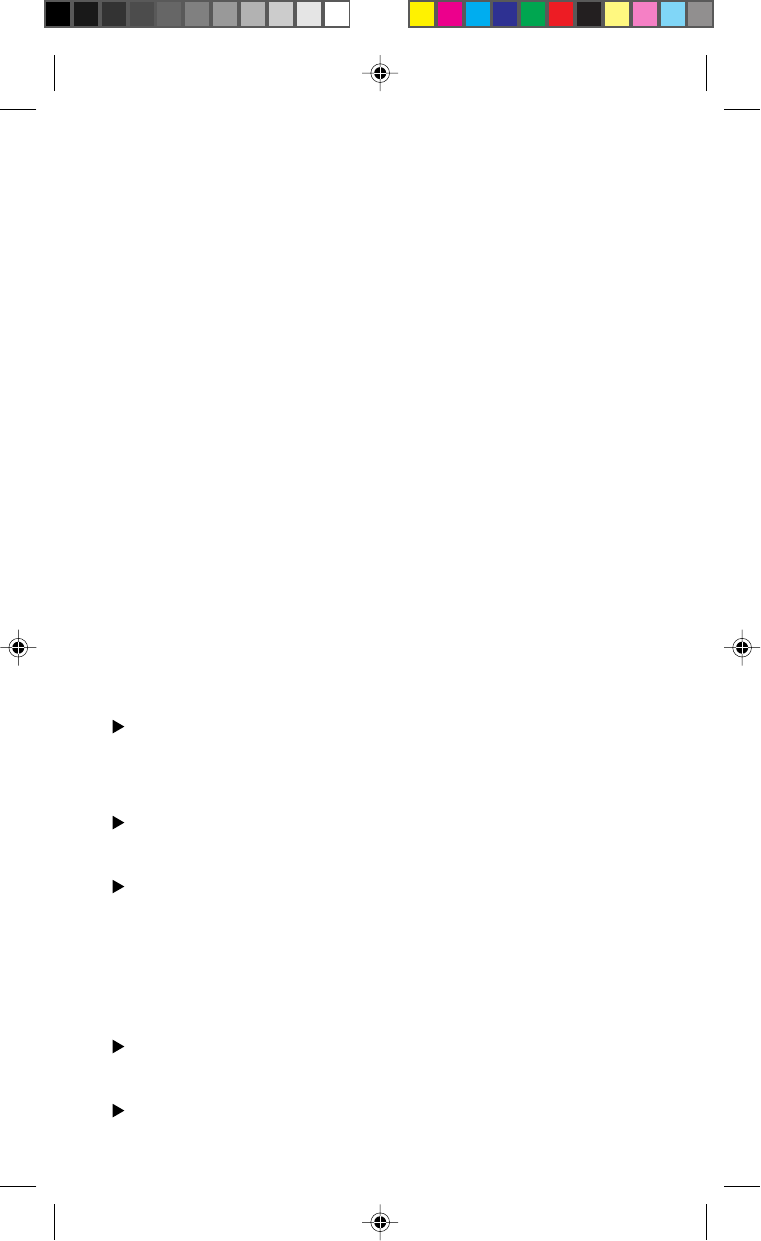
1
First things first:
Call us to get activated.
Before you can use your new Sprint PCS Phone™, you need to
open your Sprint PCS Account – in other words, activate your
phone. You do that by calling 1-888-715-4588 (in Southern
California, call 1-800-PCS-6699) from any phone other than your
new Sprint PCS Phone.
This call is toll-free.
Note: If a Sprint PCS Sales Representative has already activated
your phone, then there’s no need to place this call. Instead, see
“How to unlock your phone” on the next page.
What you should know before you call.
The call may take up to 30 minutes, but may take longer at peak
time.
A credit check will be run.
Your Sprint PCS Phone will be ready for use about an hour after
this call is finished.
What you should have handy.
Your new Sprint PCS Phone
The original packaging for your new phone
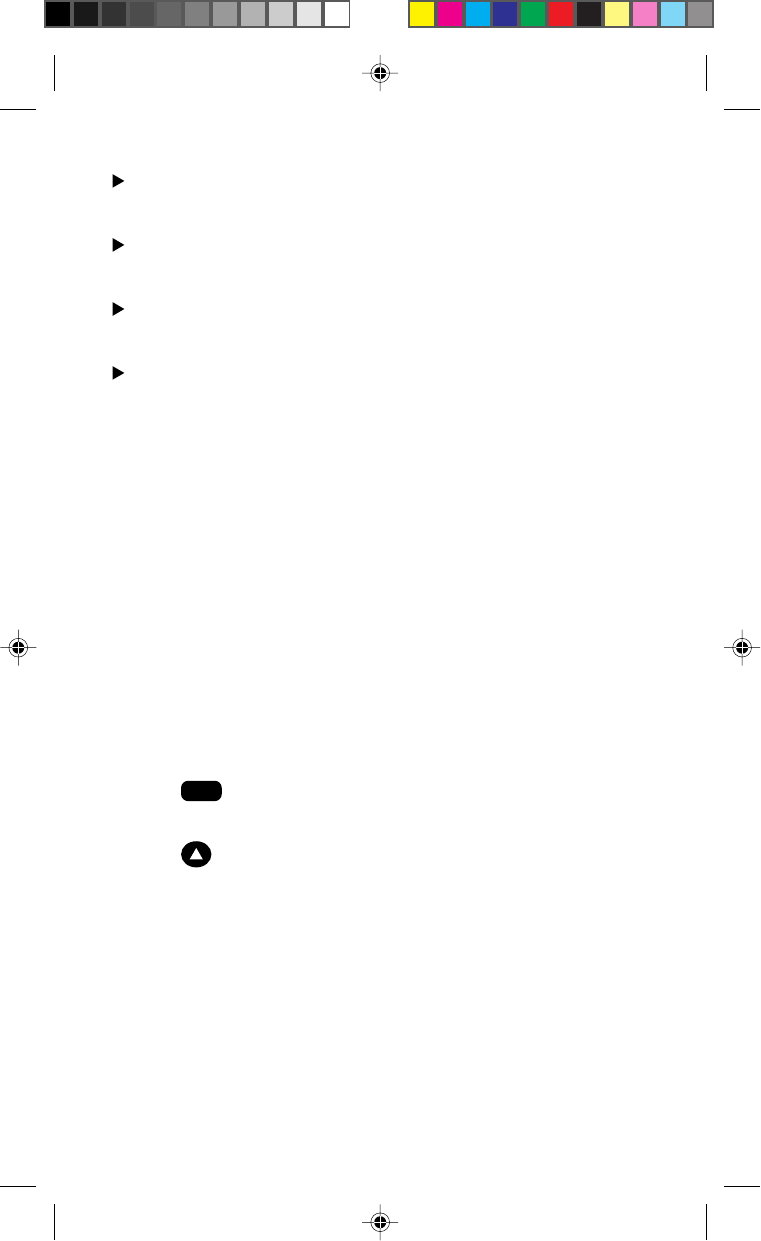
2
Your billing address
Your social security number or tax ID number
Your driver’s license number
Pen and paper to write down your new Sprint PCS Phone
Number
During this call, a Sprint PCS Customer Advocate will collect your
information as well as help you select your Sprint PCS Service
Features and a calling plan. Once you’ve made all your selections,
the advocate will guide you through the activation process.
How to unlock your phone.
If you received your phone in the mail, you need to unlock it
before you can begin making calls. Just follow these simple steps:
1. Press POWER to turn on the phone.
2. Press under [UNLOCK].
3. Enter the four-digit lock code. (This code typically is the last
four digits of your Sprint PCS Phone Number or the last four
digits of your social security number.)

3
How to get help.
If you need help with this or anything else, we hope you’ll call
Sprint PCS Customer Care at 1-888-211-4PCS (4727). In Southern
California, call 1-800-455-4551. You also can press
TALK
from your activated Sprint PCS Phone (in Southern Califor-
nia, press
TALK
). A Sprint PCS
Customer Advocate will answer (24 hours a day) and be happy to
assist you.
Our services are provided to you under certain terms and condi-
tions – all of which are listed in the brochures included in the box
your phone came in.

4

5
Table of Contents
First things first: Call us to get activated. 1
What you should know before you call. 1
What you should have handy. 1
How to unlock your phone. 2
How to get help. 3
Introduction. 9
Getting to know your phone. 10
Function keys 12
Display icons: What they tell you. 14
Using the battery. 15
Installing and removing the battery. 15
Charging the battery. 15
Charging with the AC adapter. 16
Turning your phone on and off. 17
Standby status. 17
Power Save mode. 18
Basic functions. 19
Making a call. 19
Correcting dialing mistakes. 19
Answering calls 20
Where you can use your phone. 20

6
What you’ll see. 21
Calling experience. 22
Using Caller ID. 23
Responding to Call Waiting. 24
Using Three-Way Calling. 25
Using Call Forwarding. 25
Redialing calls. 26
Getting your own phone number. 26
Adjusting volume. 27
Locking the keypad. 27
Emergency dialing. 28
Calling 911. 28
Saving and editing emergency numbers. 28
Dialing other emergency numbers. 29
Dialing Sprint PCS Directory Assistance. 30
Dialing Sprint PCS Operator Services. 30
Setting up your voicemail. 31
Finding out you have a message. 32
Internal phone book, Call history and Scratch pad. 33
Understanding your phone’s memory. 33
Saving and storing a phone number. 33
Looking up a phone number. 35
Finding a number using a person’s name. 35
Finding a number when you know at least four digits. 36
Editing a phone number. 37
Erasing a phone number. 38

7
Finding a number using its memory location. 38
Using One-Touch/Two-Touch Dialing. 39
For memory locations 1to 9: 39
For memory locations 10 to 99: 39
Using Speed Dial. 38
Reviewing your Recent Call History. 40
Saving in Scratch Pad Memory 41
Reviewing your Scratch Pad memory. 42
The scratch pad memory will be erased when: 42
Advanced features. 43
Using the pause feature to dial faster. 43
Inserting a pause in a number. 44
Punctuating names. 44
Using uppercase and lowercase letters. 45
Dialing from your phone book to a different area code. 45
Help guidance for the internal phone book. 46
Main menu. 47
Navigating through the menu. 47
Taking a menu shortcut. 47
Understanding menu items. 48
Adjusting your phone’s volume. 48
Choosing what you see on the screen. 49
Choosing the vibration. 50
Choosing the right alerts. 51
Keeping track of calls. 51
Maintaining phone security. 52
Customizing the way your phone works. 55

8
Choosing the analog system. 57
Preventing accidental key press. 57
Usage guidelines:
All about performance and safety. 58
Keeping tabs on signal strength. 58
Understanding Power Save mode. 58
Understanding how your phone operates. 59
Radio frequency safety. 59
Maintaining your phone’s peak performance. 60
Protecting your battery. 61
Using your phone while driving. 62
Disposal of Lithium Ion batteries. 63
Following safety guidelines. 63
Using your phone near other electronic devices. 63
Turn off your phone before flying. 64
Restricting children’s access to your phone. 64
Turn off your phone in dangerous areas. 65
Cautions. 66
FCC notice. 66
Index 68
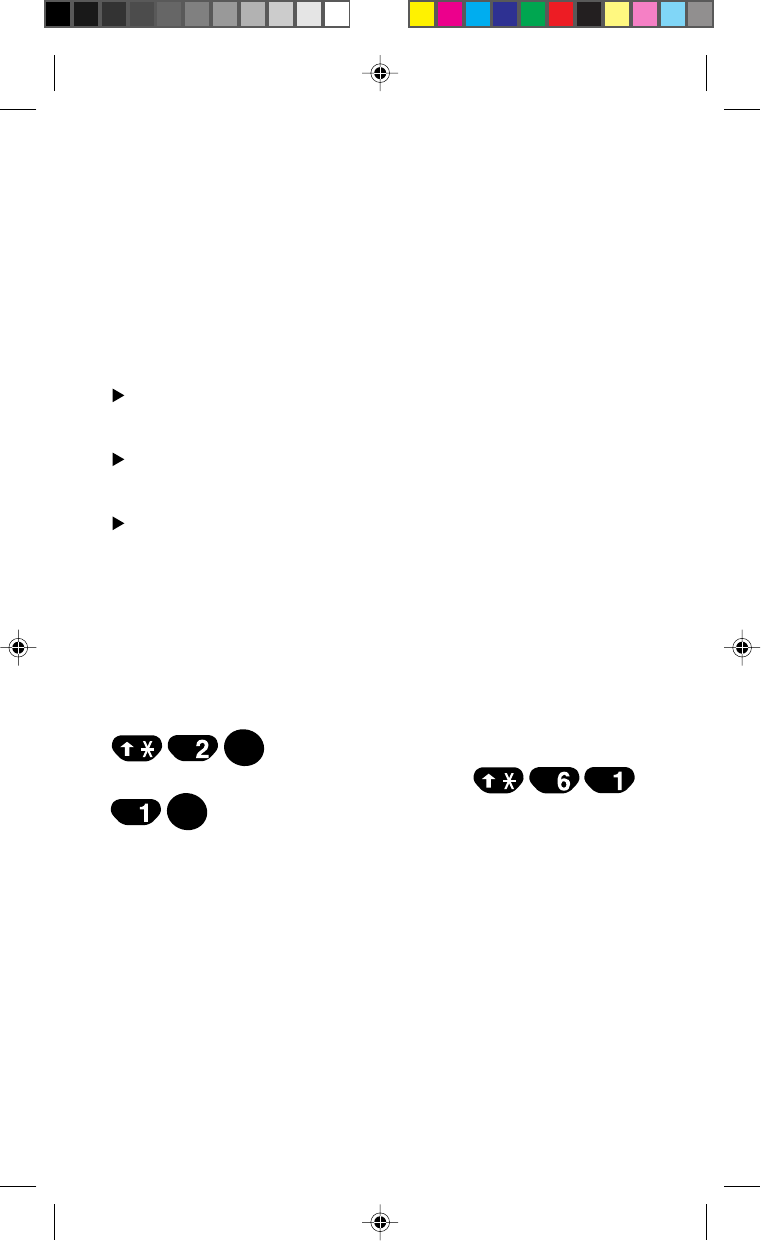
9
Introduction.
Congratulations on your purchase of a Sprint PCS Phone. This
phone is quite versatile because it lets you make and receive calls
in so many places:
Anywhere within the nationwide Sprint PCS Network
On other select PCS CDMA networks
On analog cellular networks (that’s the old cellular technology)
And although it comes standard with many exciting features, like
voicemail, an internal phone book and Call Waiting, it’s still so
easy to use. Just follow the simple steps described inside.
Of course, you can always call us if you need any help. Just press
TALK
from your Sprint PCS Phone and we’ll be
happy to help. (In Southern California, press
TALK
.)
Thanks for choosing Sprint PCS.

10
Getting to know
your phone.
1. Red Light: Illuminates when POWER is pressed and when you’ve got
incoming calls and messages.
2. Headset Jack: Insert the plug of the headset (not supplied).
3. Soft Key Labels: Tell you what the current options are for the Soft
Keys.
4. Soft Keys: Used to choose the option that is currently displayed
above that key.
5. TALK: Lets you place a call, answer Call Waiting and place a three-
way call.
6. MUTE: Switch the microphone on and off while in a call. When the
microphone is off, the other party can not hear you. Turn the ringer
sound off while ringing or while standby mode.
7. INFO: Provides phone book guidance, displays your phone number
and enter pause and hyphen.
8. Scroll Keys: Allow you to scroll through the menu options and
displays.
9. POWER: Turns the phone on and off.
10. VOLume: Lets you adjust the sound level and scroll through the
menu options.
11. CLR: Allows you to clear characters from the screen or back up
menu levels.
12. END: Lets you disconnect a call and return to standby mode.
13. Message Key: Lets you access your voicemail box and listen to
your messages.
14. Antenna: Makes the voice on the other end sound clearest when it’s
all the way up.

11
Sprint PCS
Location ??
auto= 01
( OK)( NEXT)
4. Soft Keys
5. TALK
3. Soft Key
Labels
7. INFO 11. CLR
9. POWER
8. Scroll Keys
6. MUTE
10. VOLume
12. END
2. Headset Jack
13. Message
Key
14. Antenna
1. Red Light
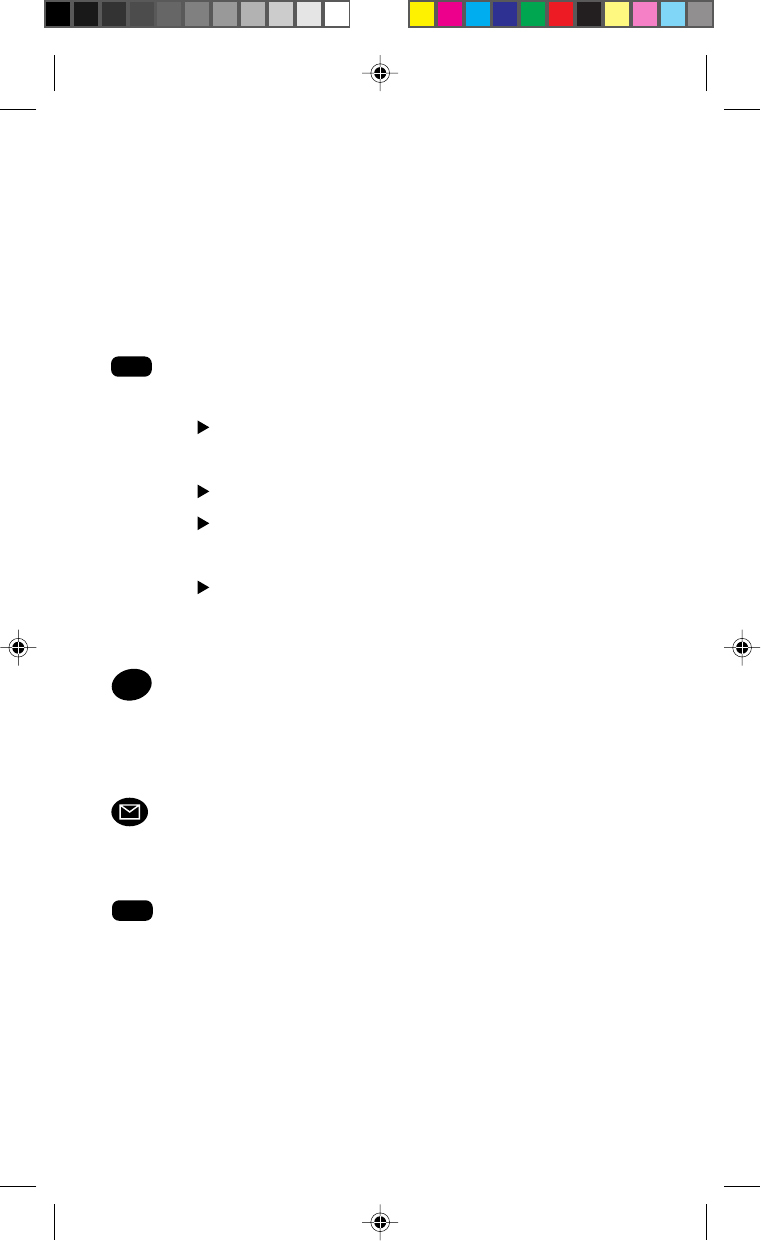
12
Function keys.
The following keys perform these functions when pressed during
most procedures.
CLR
This key lets you do lots of things:
To erase one character from the display screen,
briefly press it once.
To erase all of them, hold it down for one second.
To back up one menu level when you’re accessing
menu options, press it once.
To revert back to the stadby display, hold it down for
two seconds.
END
Press this key to disconnect a call. You can also press it
to exit out of a menu and return to the phone’s standby
display.
The message key lets you easily access voicemail
messages.
INFO
Press this key to insert hyphens as well as hard or timed
pauses when you’re programming a number in your
phone’s memory (See page 44). This key also gives you
phone book guidance. You can press this key to display
your Sprint PCS Phone Number when the main screen
is displayed.
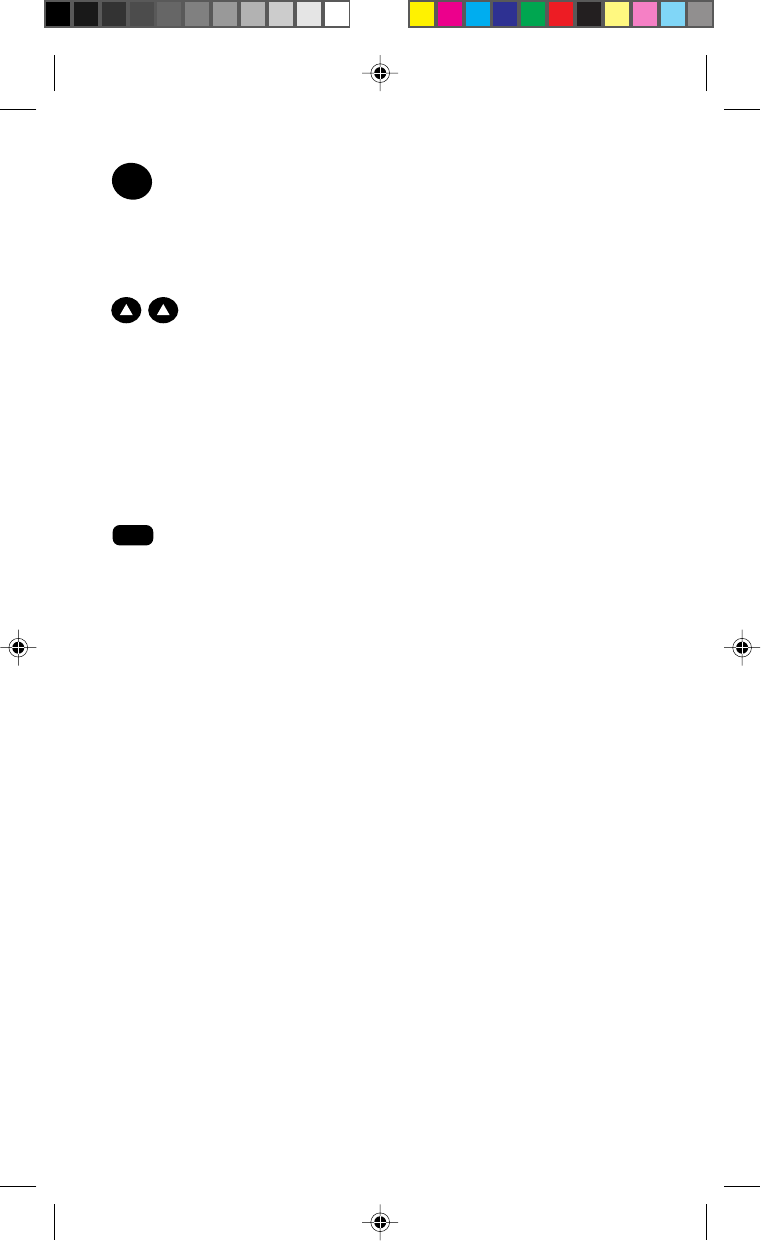
13
TALK
Press this key to place and receive calls, to access a
second incoming call from call waiting or initiate Three-
Way Calling.
Press either Soft Key to choose the operation displayed
in the Soft Key Labels directly above that key. Different
labels will be displayed above the Soft Keys depending
on the menu you’re in or the task you’re performing.
Each time you press a Soft Key, a new label may be
displayed.
MUTE
Press this key to switch the microphone on and off
while in a call, to turn the ringer sound off temporarily
while ringing or to turn the ringer sound off until power
off while standby mode.

14
Display icons:
What they tell you.
Display icons are all the graphic symbols that show up on your
display screen. In short, they tell you what’s going on. Just look
below.
Signal
No Service
In Use
Roaming
Messages
Vibrate
Analog
Battery
Measures your current signal strength. The more
lines there are, the stronger the signal.
This means the phone is outside service areas.
When this is displayed, you cannot use your phone.
Tells you a call is in progress.
If the icon is not displayed, you are in the Sprint
PCS Network. If it is displayed (it may or may not
be flashing), you are on another service provider’s
network.
Indicates when you have messages waiting.
Indicate when the vibrate feature is set to ON.
Indicates when using the phone in the analog
system.
Shows the level of your battery charge. The more
black you see, the more power you have left. When
the charge is low, this icon blinks and an alert tone
is sounded.

15
Using the battery.
Your Sprint PCS Phone comes with a rechargeable battery pack.
Remember to fully charge your battery as soon as the charge
becomes low in order to maximize your talk time and standby
time.
Installing and removing the battery.
The battery pack snaps easily onto the back of the phone (bottom
end first) for quick installation and removal. Make sure to turn the
power off before removing the battery. Otherwise, you could lose
stored numbers and messages.
Charging the battery.
You can tell whether or not your battery needs to be recharged just
by checking the upper-right corner of your phone’s display. When
the battery charge level gets low, the battery icon will blink
and the phone will sound a tone. If the battery level gets too low,
the phone will turn off automatically. Three alert tones will sound
just before the phone turns itself off. If this happens, unfortunately,
you’ll lose whatever you were just doing. So watch that indicator
and make sure your level is okay.

16
To charge your battery, you should use the standard AC adapter, or
the optional dual port desktop charger or rapid charging cigarette
lighter adapter. Using unauthorized ones could cause damage. (The
AC adapter is described in the next section. For more information
on the desktop charger and rapid charging cigarette lighter adapter,
see the product user guide for each.)
Charging with the AC adapter.
Only use SANYO-approved adapters, model number SCP-01ADT,
with your Sprint PCS Phone. Using an unauthorized one could
cause damage.
1. Plug the adapter into a wall outlet.
2. Plug the other end into the bottom of your Sprint PCS Phone,
with the battery attached.
Charging a completely discharged standard Lithium Ion battery
takes up to four hours.
If your phone is turned on, the red light will go on while charging
and icon on display will blink when charge is completed
If your phone is turned off, the red light will go on
and “battery is charging” will show on display while charging, and
icon on display will blink when charge is completed.

17
Turning your phone on and off.
When you’re ready to turn your Sprint PCS Phone on, check to see
that the charged battery has been installed on the back of the phone
or that you have external power (meaning the rapid charging
cigarette lighter adapter, hands-free car kit or AC adapter) with the
battery pack installed. Then, simply press POWER for one second.
The red light flashes briefly and the banner is displayed, which
means you’re ready to make a call.
To turn your phone off, press POWER for one second until “Powering
Off” is displayed. Then release POWER . When your phone is turned
off, nothing is displayed on the screen.
Note: If POWER is pressed for less than one second, the phone will
not turn on or turn off. This keeps your phone from being turned
on or turned off accidentally.
Standby status.
Standby is the most basic state of the phone. The phone goes into
standby status soon after you turn it on or whenever you press
END
. When your phone is in standby status, you will typically see
the banner (that’s the message that’s displayed when you turn on
your phone). You’ll also have access to the phone’s directory and
features.

18
Power Save mode.
Your Sprint PCS Phone comes with a Power Save feature that will
be activated automatically if your phone hasn’t been able to find a
signal after 15 minutes of searching. While this feature is active,
the phone’s battery charge is conserved. The phone will automati-
cally recheck for a signal periodically. To manually force the
phone to recheck for a signal, press any key. A message on the
display will let you know when the phone is operating in Power
Save mode.

19
Basic functions.
Making a call.
Whenever you make a call, follow these simple steps:
1. First, check to see that your phone is on. If you see the display
indicators on the screen, that means the power is on.
2. Enter the phone number you’re calling.
3. Press
TALK
.
4. When you’re finished with your call, just press
END
to discon-
nect.
You can also make calls from your internal phone book (see page
35) or from your recent calls list (see page 40).
Correcting dialing mistakes.
If you make a mistake while dialing a phone number, press
CLR
to erase one digit at a time. You can delete the entire number at
once by pressing
CLR
and holding it down for at least one second.

20
Answering calls.
Your phone must be turned on before you can receive calls. When
your phone rings (“Incoming Call” display and the Red Light
flash.), press
TALK
to answer. You can also answer by pressing any
key (other than POWER ,
MUTE
or
END
). Before you do this, you have
to set Any Key Answer function on(See page 56).
To disconnect the call when you’re through, press
END
.
You can customize your options for answering calls using the Any
Key Answer feature on the Features menu (press after
accessing the menu to select Features). This allows you to press
any key (except POWER ,
MUTE
or
END
) to answer a call.
When the phone rings, pressing
END
or
MUTE
stops only ringing.
Where you can use your phone.
Your Sprint PCS Phone is dual band, which means you can use it
to make and receive calls in many places:
In any city where Sprint PCS provides service
On select PCS CDMA networks (like the Sprint PCS Network)
from other providers
On conventional analog cellular networks
When you use your phone in any Sprint PCS Service Area outside
your home service area, it’s called traveling. You are charged a
simple, flat rate for all travel calls you make and receive. When
you use your phone outside the Sprint PCS Network, it’s called

21
roaming. If you’re roaming in areas where Sprint PCS has agree-
ments in place with other PCS CDMA service providers, you will
be charged the travel rate. If you’re roaming in areas where Sprint
PCS has agreements in place with conventional analog cellular
providers, you will pay airtime plus long-distance charges, where
they apply.
Note: In areas where Sprint PCS does not have roaming agree-
ments in place, you will still be able to make emergency calls to
911 and calls billed to a credit card.
What you’ll see.
You should always check your phone’s display because it will let
you know when you’re outside the Sprint PCS Network and
whether your phone is not operating in analog only mode or analog
roam mode. The chart below indicates what you will see, depend-
ing on where you’re using your phone.
Regardless of whether you’re using your phone on or off the Sprint
PCS Network, you should always dial numbers using 11 digits (1 +
area code + number) when you make calls outside your Sprint PCS
Home Service AreaSM. (This does not necessarily mean you’ll be
charged a long-distance rate.)
Sprint PCS Network
Other PCS CDMA Networks
Analog Cellular
(Roaming Indicator)
X
(“CDMA Roam” flashes.)
X
(“Analog Roam” flashes.)
(Analog Indicator)
X

22
Calling experience.
When you use your phone on other PCS CDMA networks, your
calling experience will be quite similar to what you experience
when making calls from within the Sprint PCS Network. Although
certain calling features may not be available, your phone calls are
still private and secure, and in general, your call quality should be
similar to what you experience with the Sprint PCS Network.
When you use your phone on analog cellular networks, your
experience will be much different. Cellular roaming will be of the
same quality provided by cellular carriers today. Although you will
still have the convenience of being able to make and receive calls,
here are some differences you can expect:
You are more likely to experience static, cross-talk, fade-out
and dropped calls.
Some calling features that are standard within the Sprint PCS
Network will be unavailable.
You will experience the same security and privacy risks
(eavesdropping and cloning) that exist with conventional
cellular services today.
Battery life will be shorter when you use your phone for cellular
roaming than when you use it on a CDMA network.
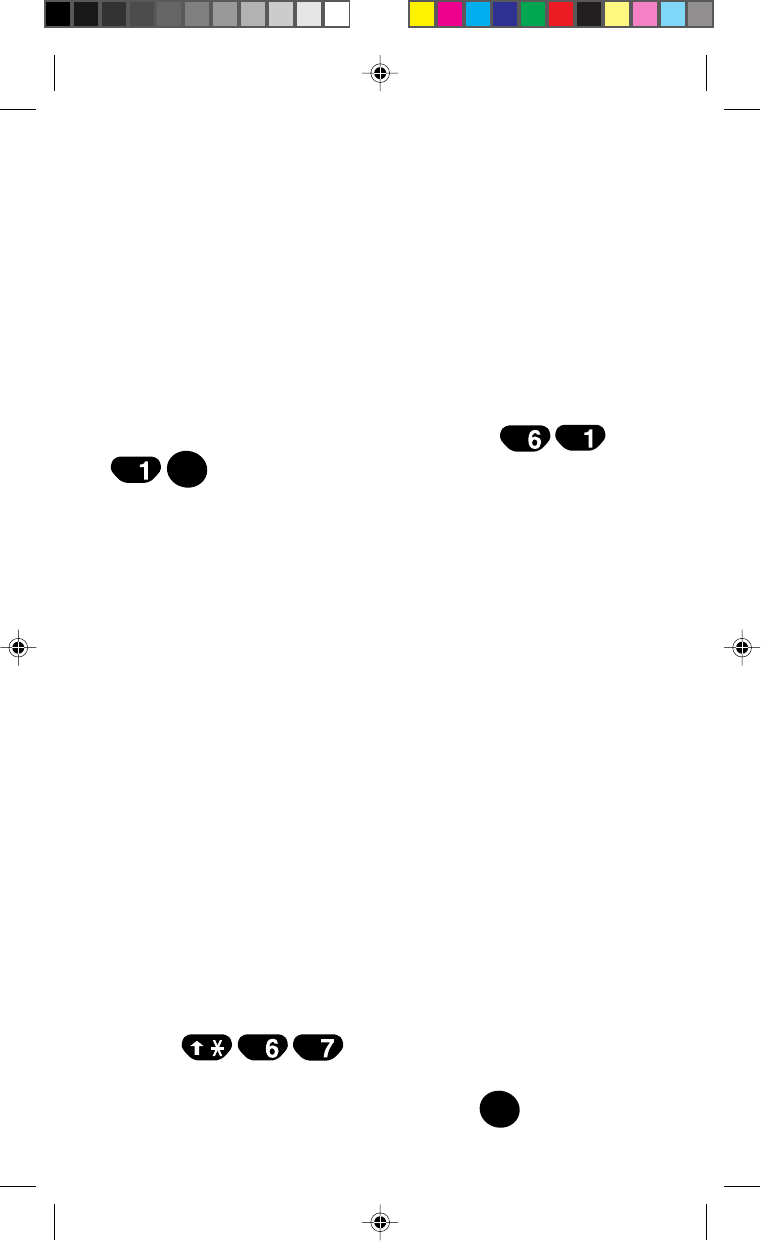
23
If you are on the phone when you leave a Sprint PCS Service Area
and enter an area where roaming is available (whether PCS
CDMA or analog cellular), your call will be dropped. If your call
is dropped in an area where you think Sprint PCS provides service,
turn your phone off and then on again to speed acquisition of the
Sprint PCS Network.
If you need customer service for any reason while using your
phone outside the Sprint PCS Network, just dial
TALK
from your Sprint PCS Phone. However, because
you’re outside the Sprint PCS Network, you may reach the local
service provider’s customer service instead of Sprint PCS Cus-
tomer Care. To be sure that you reach Sprint PCS Customer Care,
dial 1-888-211-4PCS (4727).
Using Caller ID.
This feature tells you who is calling you on your Sprint PCS Phone
by displaying their number when the phone rings. If a caller’s
name and number are stored in your internal phone book, the
corresponding name is also displayed. If you call someone who
has this feature, your Sprint PCS Phone Number will be displayed
on their phone.
To block your Sprint PCS Number from being displayed for a
particular outgoing call, just follow these steps:
1. Press .
2. Dial the outgoing phone number and press
TALK
.

24
To block your Sprint PCS Phone. Number from being displayed on
all of your outgoing calls, just call Sprint PCS Customer Care by
pressing
TALK
(in Southern California, press
TALK
). Once you have permanently blocked
your number, you can release the block for a particular call. To do
that, follow these steps:
1. Press .
2. Dial the phone number and press
TALK
.
Responding to Call Waiting.
If you’re in the middle of a call and you hear a beep, that means
you have another call coming in. If you don’t answer the call
within 10 seconds, you will be reminded of the incoming call with
a second beep. To put the first caller on hold and answer the
second call, press
TALK
. Press
TALK
again to switch back to the
first call.
If you don’t want to be interrupted during a particular call, you can
temporarily disable Call Waiting. Just press
before dialing the number. Once you end that call, Call Waiting
will be reactivated automatically. If you don’t want to be inter-
rupted during any of your calls, before making any more, press
TALK
(in Southern California, press
TALK
) to call Sprint PCS Customer Care and have
Call Waiting deactivated.

25
Using Three-Way Calling.
Three-Way Calling lets you talk with two different people at the
same time. Simply dial your first number and press
TALK
. When
you have connected, press
TALK
to put the first caller on hold.
Next, dial the second number and press
TALK
. When you’re
connected, press
TALK
again to begin your three-way call. When
you use this feature, you will be charged normal airtime rates for
each of the two calls you make.
Using Call Forwarding.
With Call Forwarding, you can have all of your incoming calls
forwarded to another phone number – even if your Sprint PCS
Phone is turned off. When Call Forwarding is activated, you can
still make calls from your Sprint PCS Phone. To activate Call
Forwarding, follow these steps:
1. Press .
2. Enter the area code and seven-digit phone number to which
your calls should be forwarded.
3. Then press
TALK
. You will hear a tone that confirms you’ve
activated Call Forwarding.
To deactivate Call Forwarding, press
TALK
. Once again, you’ll hear a tone to confirm the deactivation.

26
Redialing calls.
To redial the last call you made from your Sprint PCS Phone, press
TALK
. When the number is displayed, press
TALK
again. You also
can redial any of your last 10 calls using your recent calls list (see
page 40).
Getting your own phone number.
You probably don’t call your own Sprint PCS Phone Number very
often, so you may forget it. If you do, here’s an easy way to get it:
Turn your phone on and your number will be displayed briefly.
If you miss it, press
INFO
to see it again anytime your phone is
either in standby or talk mode.

27
Adjusting volume.
The volume keys
VOL
VOL
of your Sprint PCS Phone perform
three critical functions. They let you:
Adjust the earpiece volume during a call.
Adjust the ringer volume or even turn it off when you’re in
standby mode.
Scroll through menus.
Locking the keypad.
To avoid accidental key presses, you can lock the keypad. How-
ever, you’ll still receive incoming calls and messages. (This feature
can be activated only when the phone is in standby mode.)
Any Key Answer does not work in this mode.
To lock your keypad, press under [MENU] and (Key
gurad).
To unlock your keypad, press and hold
END
.
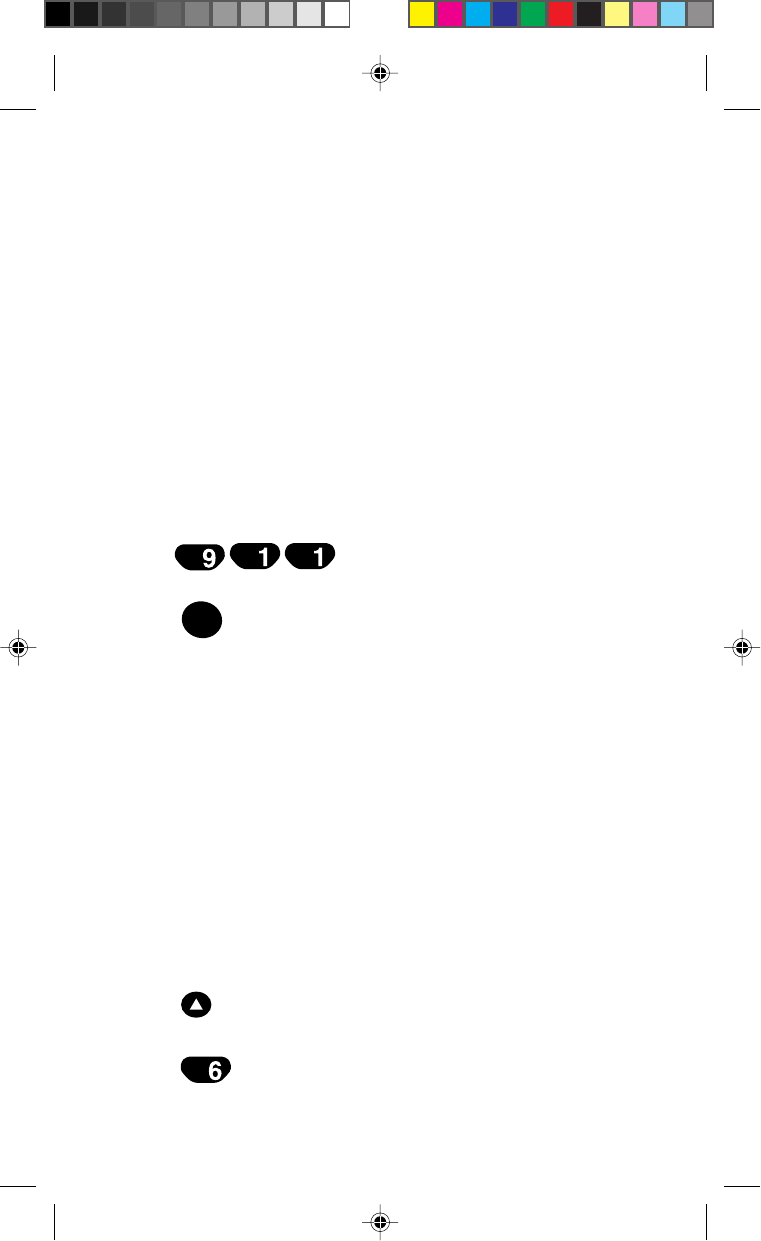
28
Emergency dialing.
You can place calls to 911, or one of the other three emergency
numbers that are in your emergency number list, even if your
phone is locked or restricted. (For information on locking or
restricting your phone, see pages 53 and 54.) As long as you’re
within a service area (check your signal strength indicator), these
numbers can be dialed.
Calling 911.
1. Dial .
2. Press
TALK
.
Note: Even if your account is restricted, you can still dial 911
(as long as you’re within a service area) but no other emergency
numbers.
Saving and editing emergency numbers.
You can save three phone numbers (in addition to 911) that can be
dialed even if your phone has been locked. To save emergency
numbers, follow the steps below:
1. Press under [MENU] .
2. Press to select the security menu.
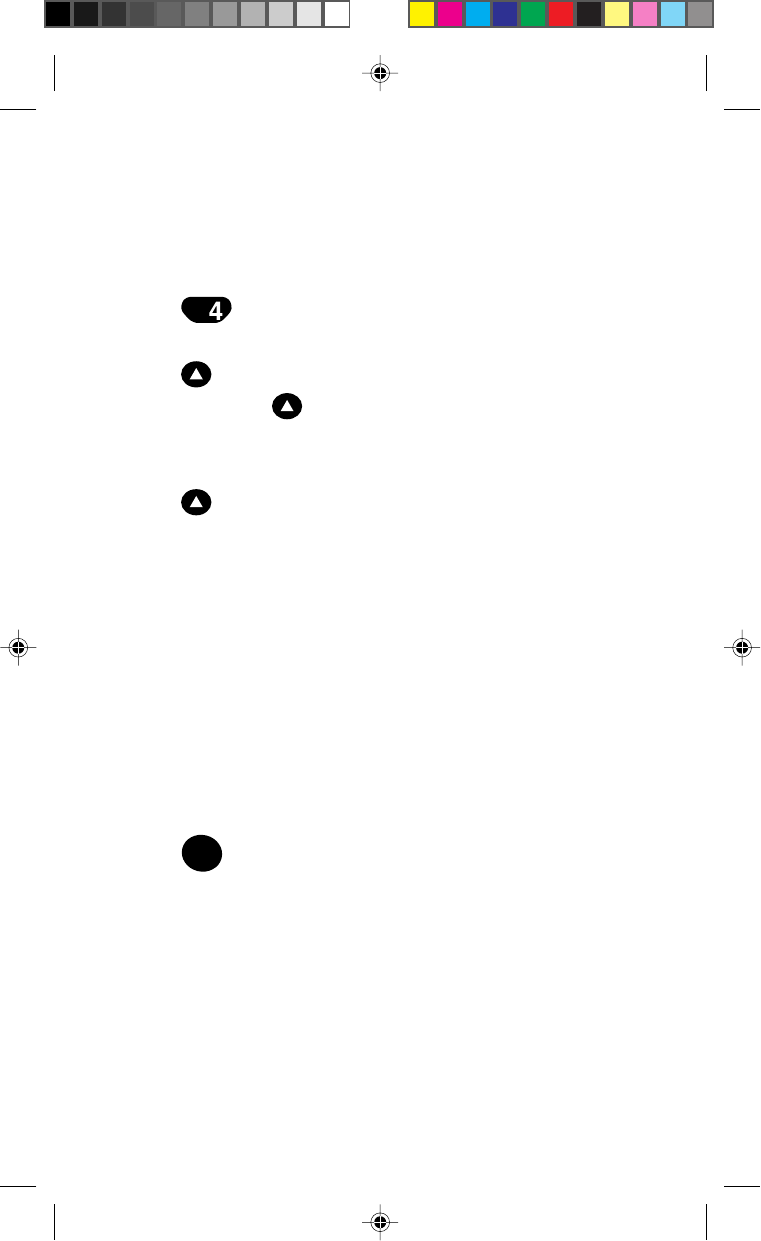
29
3. Enter your lock code. (The default code typically consists of the
last four digits of your phone number. To change your lock
code, see page 54.)
4. Press to select “EMERGENCY #.”
5. Press under [EDIT] to edit or enter the first emergency
number, or press under [NEXT] to display the next
emergency number.
6. Press under [OK] to save the entered number.
Dialing other emergency numbers.
If there’s an emergency, you can still make calls to your stored
emergency numbers even when your phone is locked.
1. Dial one of the other three emergency numbers stored in your
emergency list. Your emergency numbers must be dialed exactly
as stored – with or without the area code.
2. Press
TALK
.

30
Dialing Sprint PCS Directory Assistance.
Dial
TALK
to obtain residential, business and
government listings; to get help completing local or long-distance
calls; or to obtain movie listings, hotel, restaurant and shopping
information, and major local event information.
Dialing Sprint PCS Operator Services.
Dial to obtain assistance in placing collect calls or calls
billed to a local telephone calling card or a third party.

31
Setting up your voicemail.
To set up your voicemail, press and hold for at least one
second. Then enter “SPRINT” (777468) as your temporary pass
code. We suggest you do this soon after you activate your Sprint
PCS Account.
After entering that code, the voicemail system will prompt you to
do these things:
Create your own personal pass code. Make sure you pick a
number that you will remember.
Create the greeting that people will hear when they call you.
Record your name announcement.
Choose whether to activate One-Touch Access.
After you’ve set up your voicemail, it will automatically record
messages whenever someone calls and you don’t answer.
Whenever you need to call your voicemail from another phone,
dial your Sprint PCS Phone Number. When you hear your greet-
ing, press and enter your pass code.
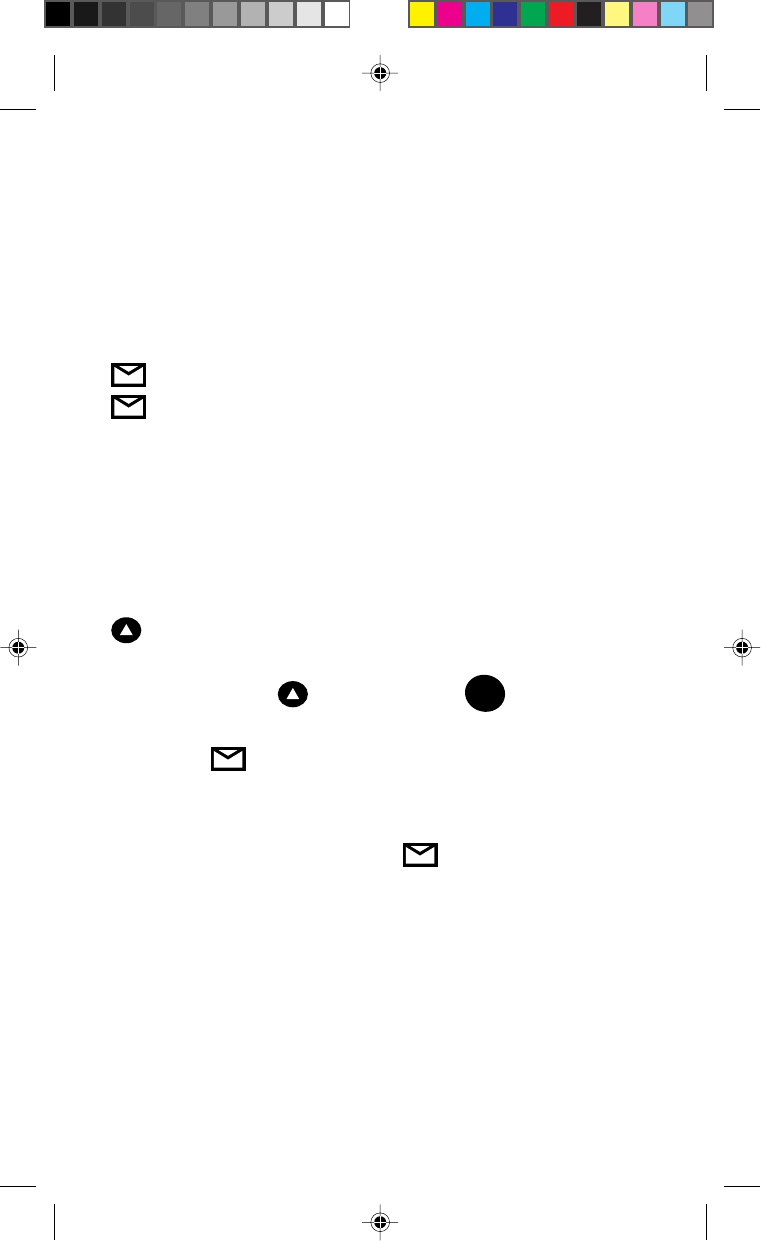
32
Finding out you have a message.
Your Sprint PCS Phone alerts you when you have new voicemail
messages in several ways: by displaying a message on the screen,
by sounding five short beeps (if the ringer is turned on), by
flashing the red light at the top of the phone, and by displaying
at the top of your screen. If a message is marked “Urgent,”
will flash. You can have up to 30 new or saved messages and
each can be stored for up to 30 days.
In addition to VOICE MAIL, there is [PAGE] and [TEXT].
[PAGE] provides notification that there has been an incoming call.
[TEXT] is a text message. Whichever the case, when a call has
been received from a person who is registered in the phone book,
the phone number and name will be displayed on the display. Press
under [READ] to displays detailed information related to the
message (and in the case of [TEXT], displays the contents of the
text message). Press under [CALL] (or
TALK
) to make a call to
person sending a message.
If you press when your Sprint PCS Phone is in standby mode,
you can check whether or not there is a message.
Your phone will continue to display until you erase your new
message or you read page or texts.

33
Internal phone book,
Call history and Scratch pad.
You get two types of phone books with your Sprint PCS Phone:
the Primary Phone Book and the Recent Call History. To make the
most of them, you really need to understand all the basic features
and functions of your new phone.
Understanding your phone’s memory.
Your Sprint PCS Phone has 99 phone book memory locations –
that is, 99 places to store phone numbers. You can store up to 32
digits within 01 through 94 memory locations and up to 54 digits
within 95 through 99 memory locations, and use up to 12 charac-
ters to give each entry a name.
Saving and storing a phone number.
When adding numbers to your Primary Phone Book, keep in mind
that memory locations 1 through 9 should be used for One-Touch
Dialing or your most commonly used phone numbers.
Secret numbers can be stored only in memory locations 90 through
99.
To save numbers, simply follow the directions below.
1. Enter the phone number that you want to save. We suggest that
you save numbers using 10 digits (area code + number).
If you enter a hard or timed pause, you can entire more than 33
digits.
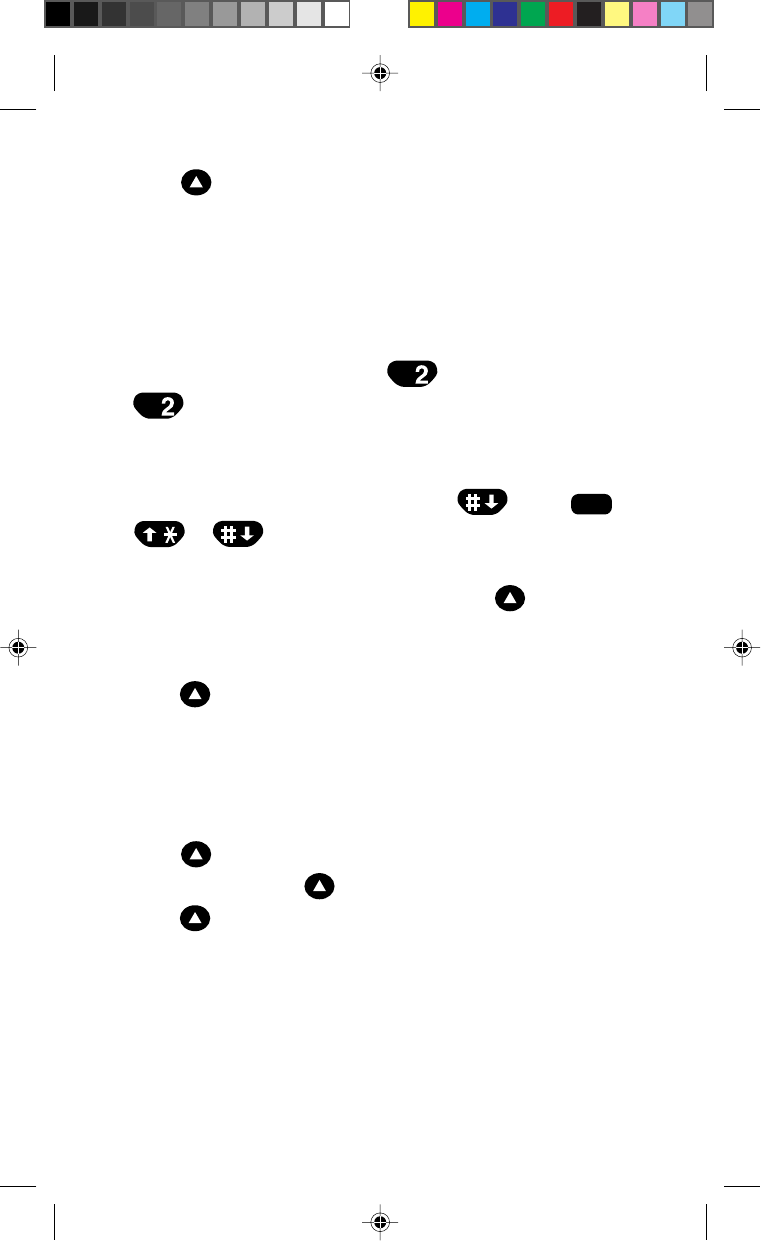
34
2. Press under [SAVE].
3. Enter the name that goes with the number (up to 12 characters).
Press the key of the first letter in the name, and continue until
you’ve spelled the whole name. Pressing a key repeatedly will
change the letter or number in the flashing cursor position on
the screen. (For example, press once for “A.” Press
twice for “B.”) When you have the correct letter or
number in position on the screen, wait two seconds for the
cursor to advance automatically one space. To add a space, wait
for the cursor to advance and then press . Press
CLR
or
or to correct any mistakes.
4. Once you’ve finished entering a name, press under [OK].
5. To store the number in the next available memory location,
press under [OK]. You have the option to specify a differ-
ent location by entering a two-digit location number.
6. The phone prompts, “Make Secret?” (Secret numbers are not
displayed on the screen and can only be deleted, not edited.)
Press under [OK] to accept the “no” default. To save the
entry as secret, press under [NEXT] to toggle to “yes” and
press under [OK].
Each time you save a new number, the phone automatically
displays a tally of numbers stored and of memory locations still
available.
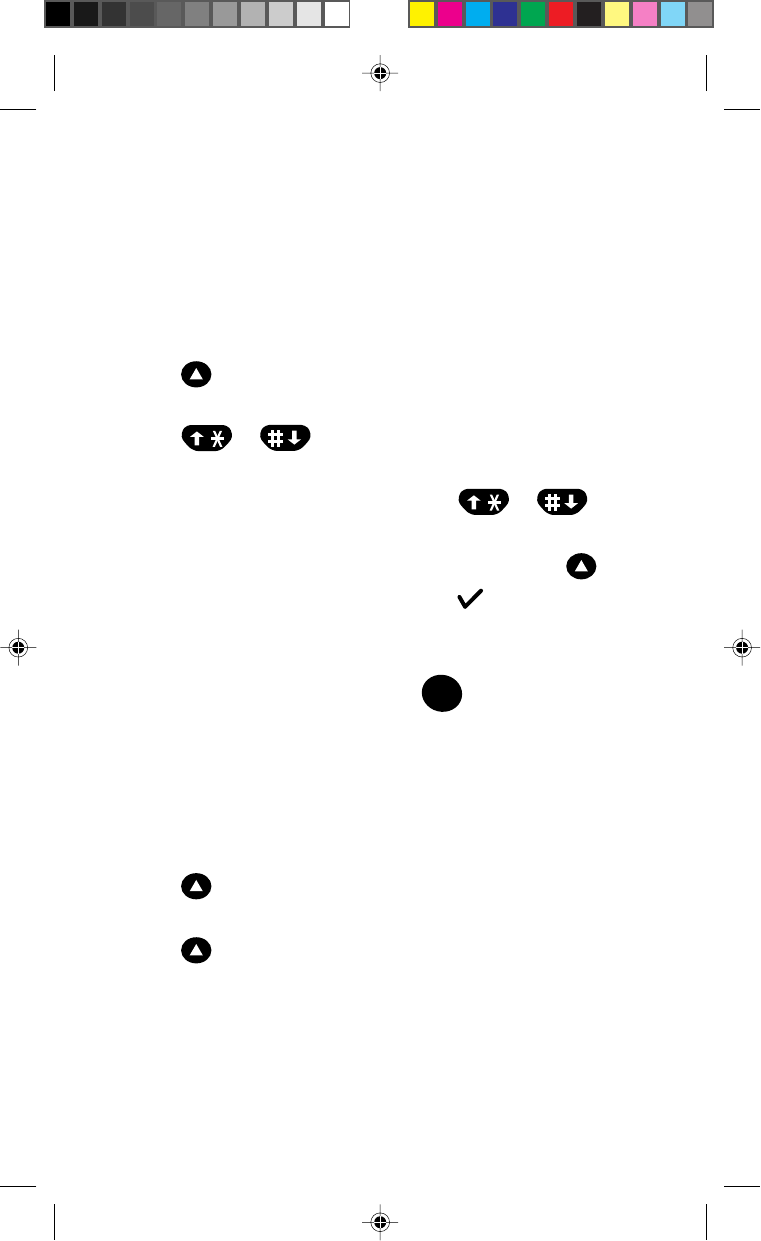
35
Looking up a phone number.
Once you have stored numbers in your Primary Phone Book, you
can review all those numbers. To display the location number,
name and phone number, follow these steps:
1. Press under [BOOK].
2. Press or to display the list of numbers.
3. To scroll through the memory list, press or .
4. To see the number stored in a memory location, press under
[VIEW] when that number is selected (“ ” mark will be
pointing to it).
5. To call the displayed number, press
TALK
.
Finding a number using a person’s name.
Just follow the steps described below.
1. Press under [BOOK].
2. Press under [NAME].
3. Enter the name of the person whose number you want to find.
You can enter two or more consecutive letters from the name if
you don’t want to enter the entire name.
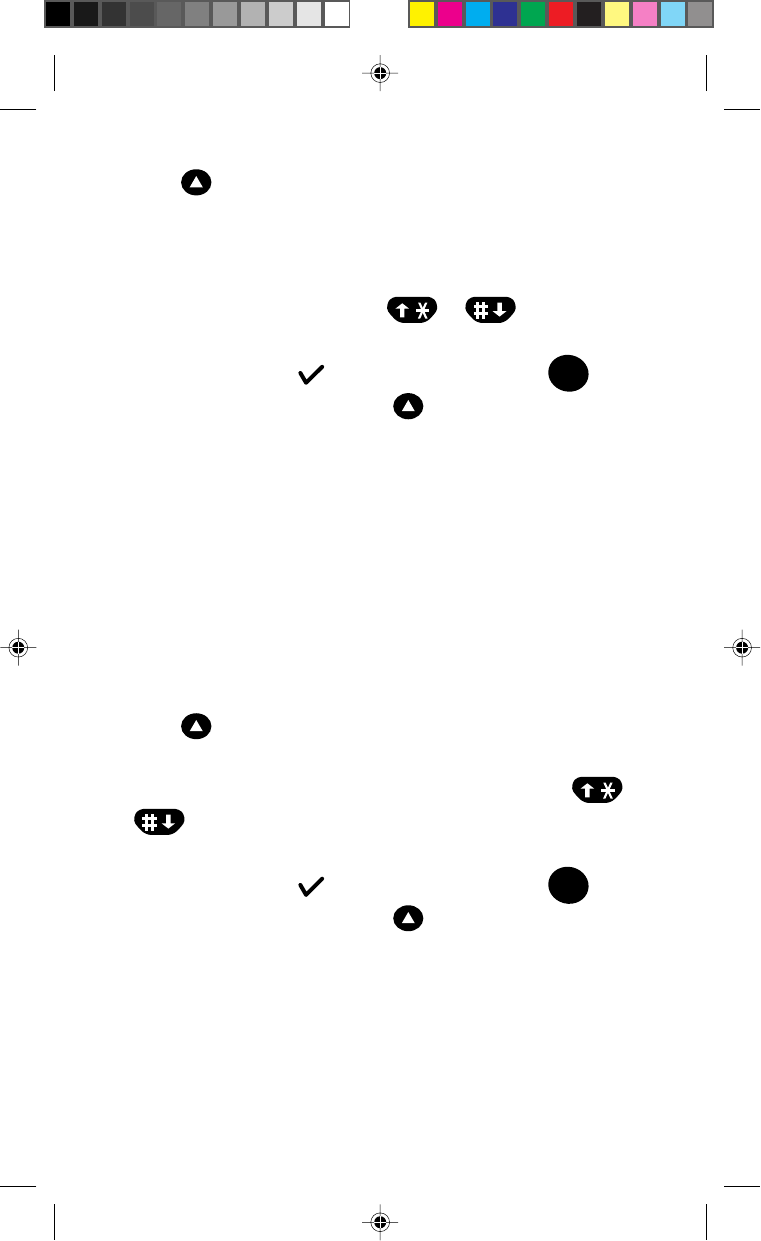
36
4. Press under [FIND]. The phone searches for names
containing those consecutive letters and displays a list of
matches.
5. To scroll through the list, press or .
6. To call the number “ ” mark is pointing to, press
TALK
, or to
display more information, press under [VIEW].
Finding a number when you know at least four digits.
This feature works only when “Digits Find” (Menu 78) is set to
“on.”
1. Enter four or more consecutive digits of the number on the main
screen.
2. Press under [FIND].
3. When the list of matching numbers is displayed, press or
to scroll to the one you’re looking for.
4. To call the number “ ” mark is pointing to, press
TALK
, or to
display more information, press under [VIEW].
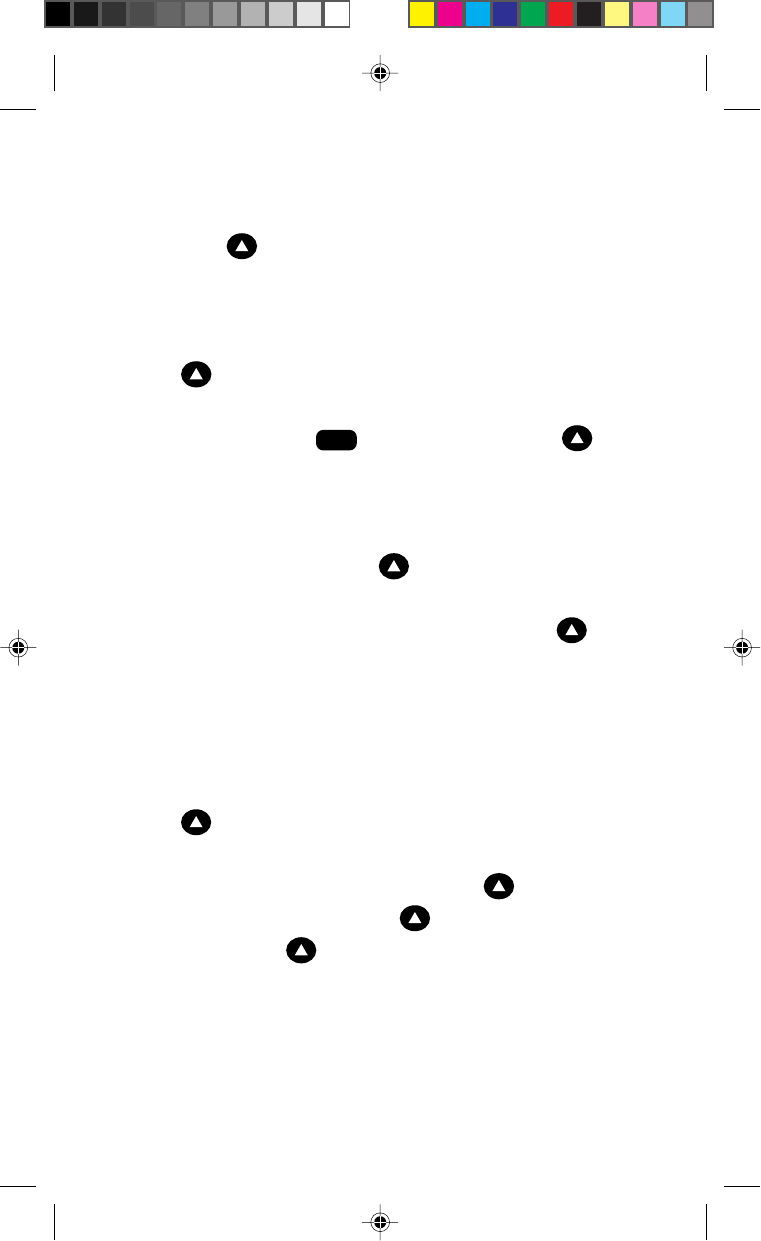
37
Editing a phone number.
1. First, press under [BOOK] and then select the memory
location you want to edit, following the steps described in the
previous section.
2. Press under [EDIT].
3. Edit the number using
CLR
and the digit keys. Press under
[OK] when you’re finished.
4. The phone displays the name that was stored previously. You
can change the name, or press under [OK] to accept it.
5. The phone then displays the memory location. Press under
[OK] to use that memory location, or enter a new one.
6. If you’re saving the edited entry in the same location or in an
already occupied location, the phone displays the name,
memory location and phone number and prompts, “Overwrite?”
Press under [OK] to accept your change.
7. The phone prompts, “Make Secret ?” Press under [OK] to
accept the “No” default, or press under [NEXT] to toggle
to “Yes” and press under [OK] to make the entry secret.
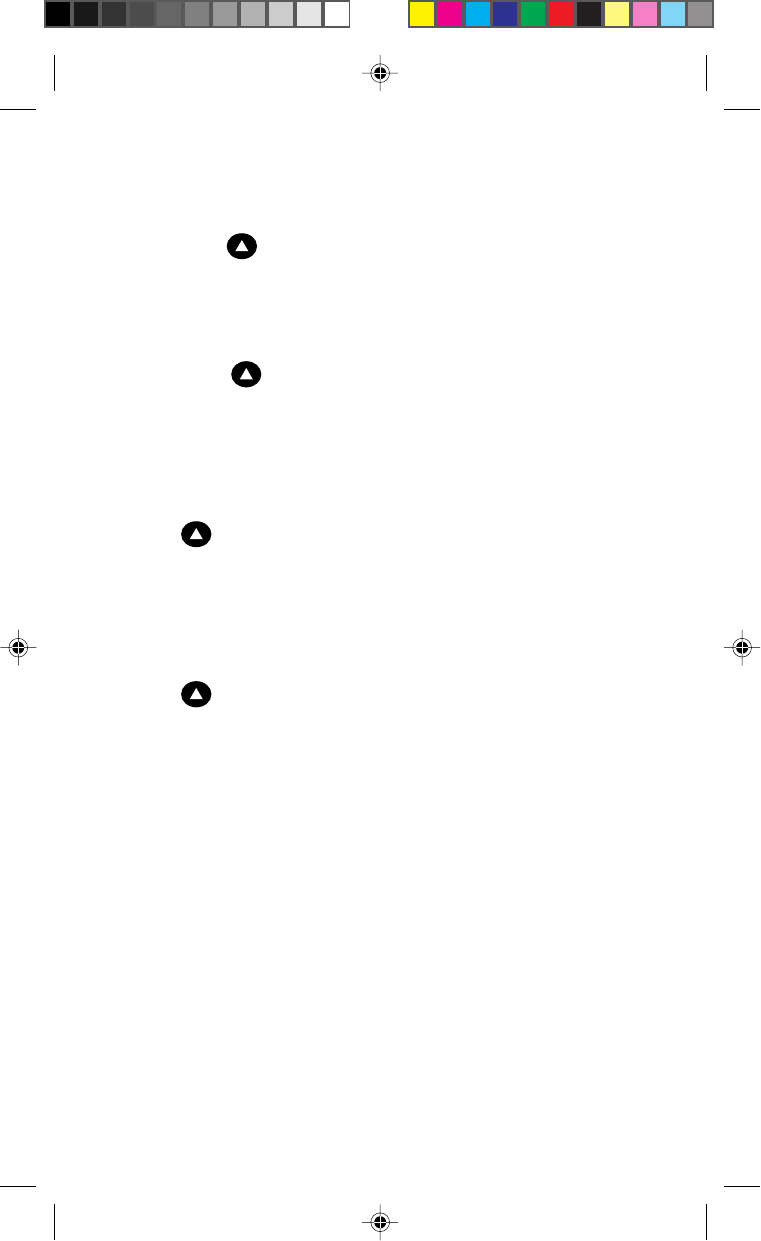
38
Erasing a phone number.
1. First, press under [BOOK] and then select the memory
location you want to edit, following the steps described on page
34.
2. Then, press under [ERASE] to erase both the name and the
number. If the number you want to erase was stored as a secret
entry, you’ll have to enter your lock code before the number
will be erased.
3. Press under [OK]. Your phone’s display will show the word
“-erased-” to confirm that the entry has been erased.
Finding a number using its memory location.
1. Press under [BOOK].
2. Enter the two-digit memory location to display the number.
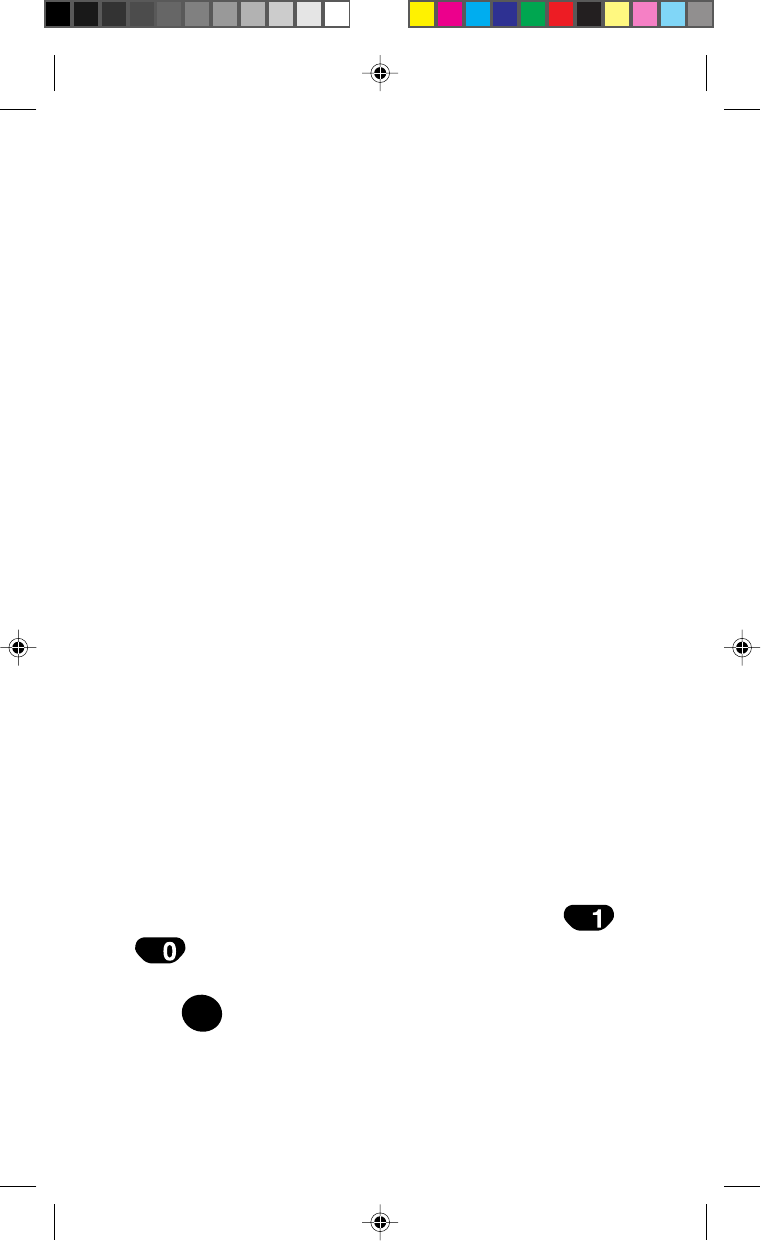
39
Using One-Touch/Two-Touch Dialing.
This feature enables you to dial phone book entries through one
key press (for locations 1 to 9) or two key presses (for locations 10
to 99). You can turn on One-Touch Dialing through the “One-
Touch” item under the “Features” menu (see page 56.).
For memory locations 1 to 9:
Press and hold the appropriate key for one second.
For memory locations 10 to 99:
1. Press the first digit.
2. Press and hold the key for second digit for one second.
Using Speed Dial.
You can dial numbers that are saved in your internal phone book
by simply pressing a couple of keys. Just follow these steps:
1. Press the key(s) that correspond to the numeric memory
location. For example, for memory location 10, press
.
2. Press
TALK
. The phone will find the number in the internal
phone book, display it on the screen and place the call.

40
Reviewing your Recent Call History.
Your Sprint PCS Phone maintains a list of the last 10 calls you
made, a list of the last 10 calls you accepted or missed and the
scratch pad memory you added. To display a list of recently made
calls, follow these steps:
1. Press under [BOOK].
2. Press under [CALLS].
3. Press to see outgoing calls (or to see incoming
calls).
4. Press or to scroll though the last 10 calls that
were made, accepted or missed.
5. When “ ” is displayed at the left of an item in the call list,
you can press
TALK
to place a call to that number. (If there’s a
name in the call list, that number has already been saved in your
phone book.)
6. When “ ” is displayed at the left of an item, you also can
press under [VIEW] for additional information on the call.
You can press under [SAVE] to save the number to a
memory location. You also can press
INFO
to display the date
and time stamp associated with the call.

41
When you’re reviewing your Recent Call History list, you’ll see
one of the following:
MISSED Indicates you have an unanswered incoming call.
CALL FROM Indicates a call you received and answered.
CALL TO Indicates a call you dialed.
Saving in Scratch Pad Memory.
1. Press under [MENU].
2. Press and during a call.
3. Enter the phone number and name you have to remember.
4. Press under [ADD] to save in Scratch Pad.
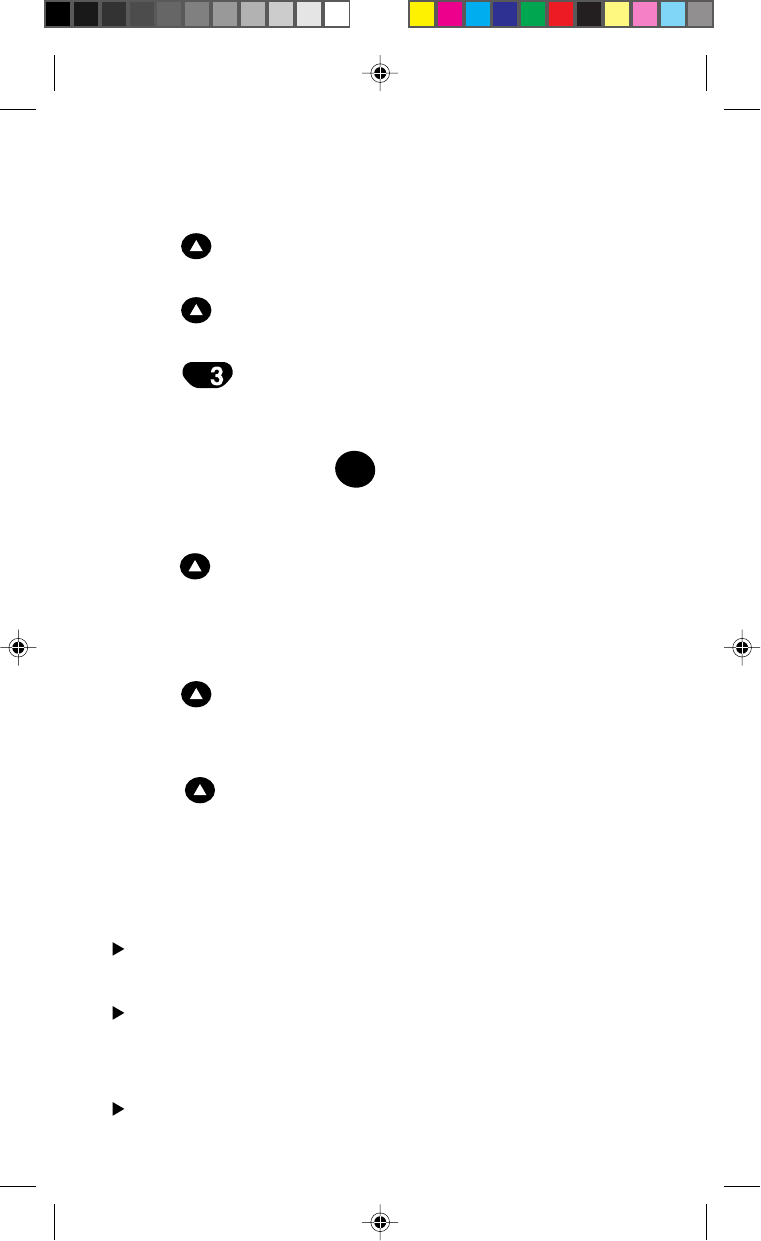
42
Reviewing your Scratch Pad memory.
1. Press under [BOOK].
2. Press under [CALLS].
3. Press to see your scratch pad memory.
4. When “ADDED” and the phone number as the scratch pad are
displayed, you can press
TALK
to place a call to that number.
5. If you want to store that number in the primary phone book,
press under [SAVE].
6. Enter the name.
7. Press under [OK].
8. To store the number in the next available memory location,
press under [OK]. You have the option to specify a
different location by entering a two-digit location number.
The scratch pad memory will be erased when:
Entering a next number as the scratch pad memory.
Saving the scratch pad memory into the primary phone book
memory.
Turning your phone off.
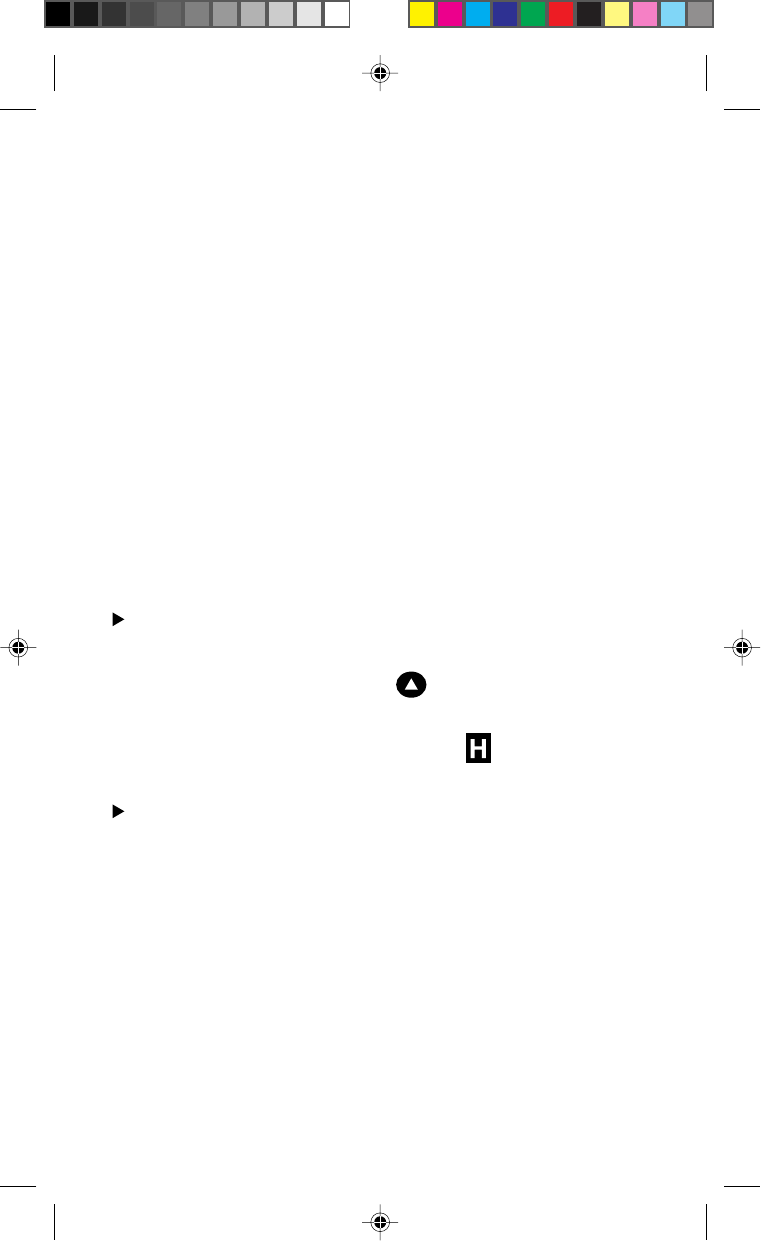
43
Advanced features.
Using the pause feature to dial faster.
This feature saves you from always having to enter a series of
numbers when, for example, you’re being prompted by an auto-
mated system or using a calling card. With your Sprint PCS Phone,
you can actually store the required series of numbers in your
internal phone book with pauses in all the right places to commu-
nicate to the automated system all the right breaks. The gist of it:
You’re able to hit a couple of numbers instead of a bunch. There
are two kinds of pauses you can insert:
Hard Pause When dialing a stored number with a hard pause,
the phone will stop dialing when it reaches the
hard pause. Press under [RESUME] when
you’re ready to send the remaining numbers. The
hard pause is displayed as on the phone.
Timed Pause When dialing a stored number with a timed
pause, the phone will stop dialing and wait for
two seconds when it reaches the timed pause.
The phone will send the remaining numbers
automatically after the two-second pause.
If a two-second pause is long enough for your automated system,
use a timed pause. If not, use a hard pause.
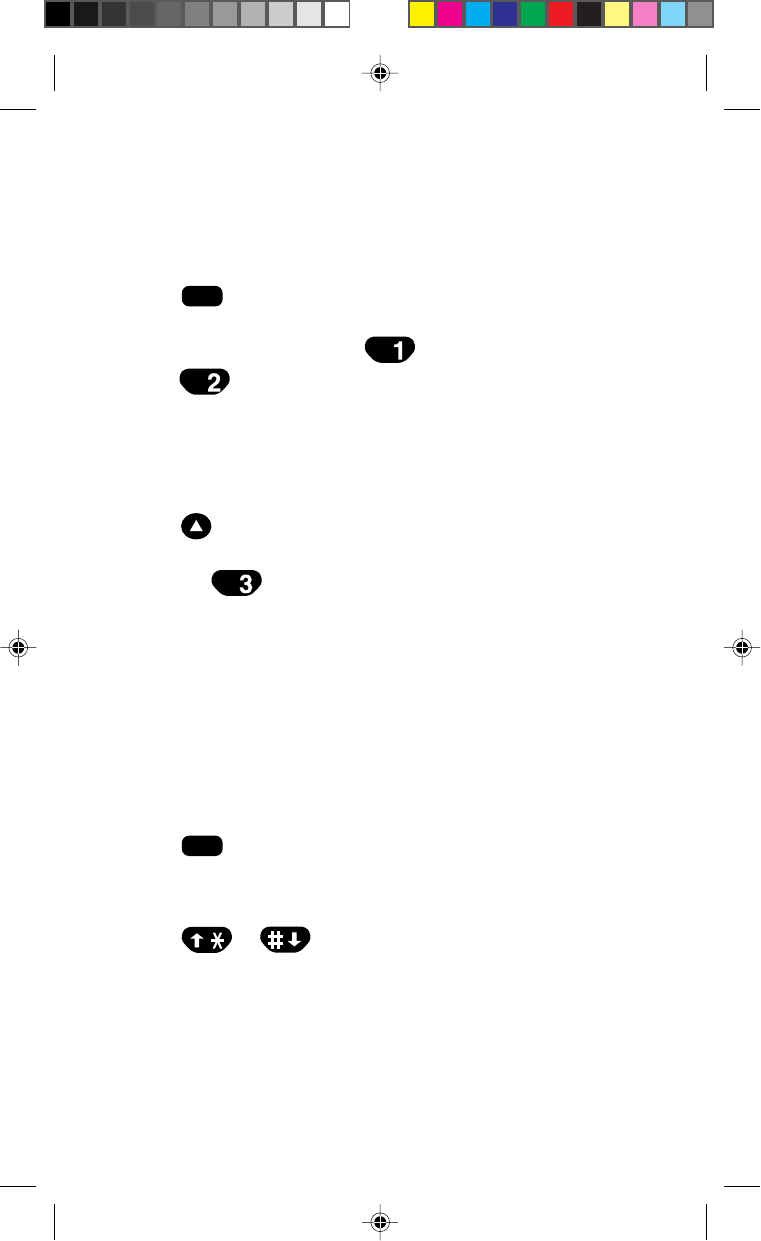
44
Inserting a pause in a number.
1. Enter the first part of the number.
2. Press
INFO
where you want to insert a pause.
3. To insert a hard pause, press . To insert a timed pause,
press .
4. Enter additional numbers (for example, a PIN or credit card
number).
5. Press under [SAVE].
Note: Press to enter a hyphen. Hyphens are used for
appearance only, your phone dials the number without any delays.
Punctuating names.
When you’re storing or editing names in your internal phone book,
you can use any of 18 special punctuation characters.
1. Press
INFO
while entering a name. (See page 34.)
A list of nine characters will be displayed.
2. Press or to display the other nine characters that
can be entered.
3. Press the number next to the character you want to enter.
4. Continue entering the name.

45
Using uppercase and lowercase letters.
When entering a name, you can use both uppercase and lowercase
letters.
1. Press under [A a] to change from uppercase letters to
lowercase letters. Press under [a A] to change back to
uppercase letters.
2. Enter the appropriate letters.
Dialing from your phone book to a different area code.
When you’re traveling outside your home service area, or when
you’re calling someone back from within voicemail, you may need
to add an area code to the stored number.
To temporarily add digits to the beginning of a stored phone
number, follow these steps:
1. Find the number you want to call. (See pages 35 and 36.)
2. Enter the area code for the number. The new numbers will be
inserted automatically at the beginning of the phone number.
3. Press
TALK
to dial the modified number.
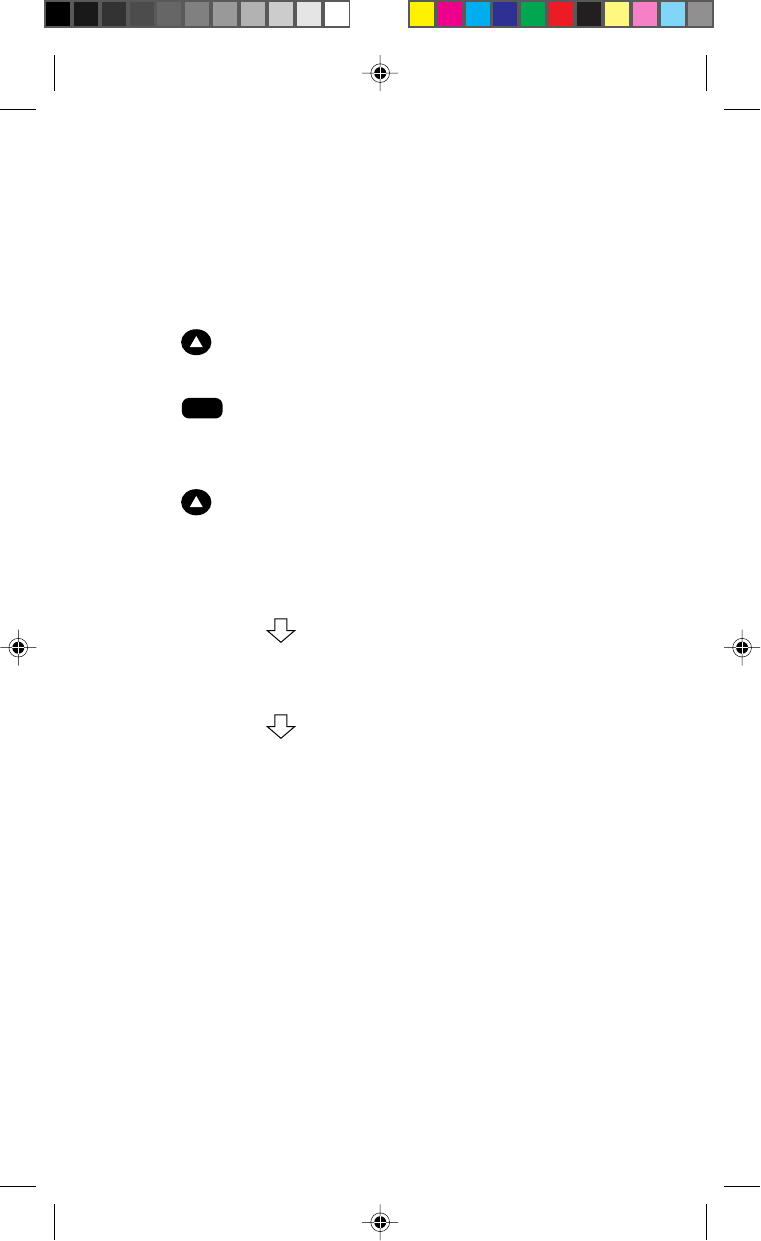
46
Help guidance for the internal phone book.
When you need a help to look up a phone number. You can operate
your phone following the instructions indicated on the display.
1. Press under [BOOK].
2. Press
INFO
.
The display shows “Recall the speed memory or used num.”.
3. Press under [HELP].
The three indications are respectively shown in the following
order for three seconds each.
“Enter speed memory # to display”
“ [NAME] to find by name
[CALLS] for used numbers”
“Press volume to display memory list”
4. After three seconds, you will see “LOOK UP Location ??”.
Then you can continue to operate following indications de-
scribed in the above step 3.

47
Main menu.
You can access all of your phone’s features and settings through
the main menu. Here’s how to go about it.
Navigating through the menu.
To display the main menu, press under [MENU].
To scroll through menu items, press or .
To go back one step, press
CLR
. You can do this at any point in
the process.
To select a menu item, press the number corresponding to it.
To scroll through possible settings, press under [NEXT], or
press or . To continuously scroll menus, press and
hold
VOL
or
VOL
.
To save a setting, press under [OK].
To exit the menu and return to the standby screen, press
END
.
You won’t save any changes. You also can press and hold
CLR
for one second.
Taking a menu shortcut.
If you’re in a hurry, just press under [MENU] and then press
the numbers that correspond to the menu options without scrolling
through the menus. For example, if you press under [MENU],
followed by and , the phone will display the volume
setting of the ringer.
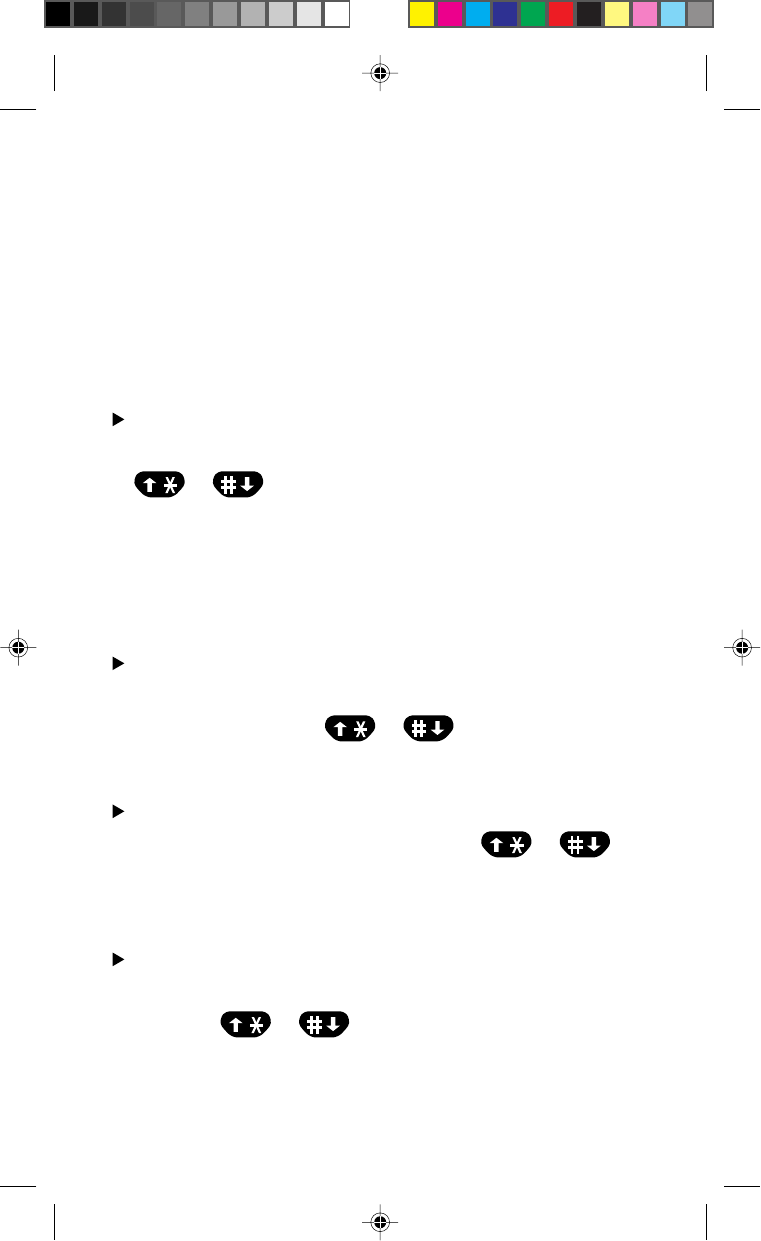
48
Understanding menu items.
Adjusting your phone’s volume.
Volume. (Menu 1) Here’s how to adjust the volume on your
phone’s ringer, key beep and earpiece.
Ringer (Menu 11)
To adjust the ringer or the message alert, you can press either
or , or the volume keys. The ringer volume can be
adjusted in 5 steps including “off.” To adjust the ringer while
the phone is ringing, only the volume keys can be used. When
“off” is selected, “Ringer Off” is shown on the display in
standby mode.
Key Beep (Menu 12)
Adjust the volume of the beep your phone makes when you
press a key by pressing or , the volume keys. The
key beep volume can be adjusted in 5 steps including “off.”
Earpiece (Menu 13)
To adjust the volume of the earpiece, press or , the
volume keys. The earpiece volume can be adjusted in 4 steps.
To make adjustments during a call, use the volume keys.
Ring Type (Menu 14)
Determine the sounds your phone makes when you receive a
call. Press or to scroll through the possible
settings (5 types). As you scroll through the list, you will hear a
sample of the ringer setting. The default setting is “RING 1.”

49
Message Ring (Menu 15)
Lets you choose how you want to be notified of short messages
(when available). Settings are: “off,” “once” and “every 2 min.”
( The default setting is “every 2 min.”)
Choosing what you see on the screen.
Display. (Menu 2) These options let you customize how things
will be displayed on your phone’s display screen.
Backlight (Menu 21)
You can manipulate the display and keypad backlighting.
Possible settings are:
• always on or always off: The “always on” option makes sure
the backlight is always on with the phone turned on. This
setting significantly increases battery drain. The “always off”
setting means that the backlight is always off except when
having incoming call.
• 10 seconds: The backlight turns off 10 seconds after you press
the last key. It is turned on again as soon as you press a key.
This is the default setting.
• 30 seconds: The backlight turns off 30 seconds after you press
the last key.
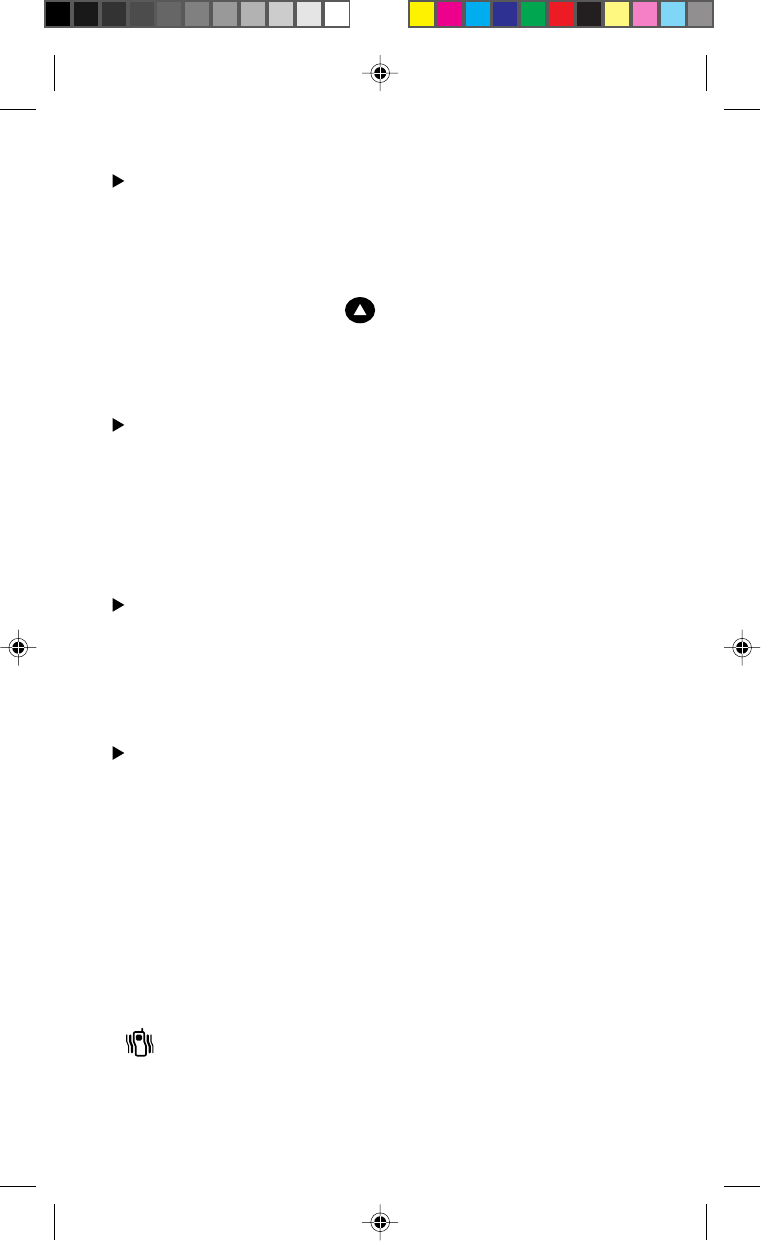
50
Banner (Menu 22)
This option lets you put whatever you want on your phone’s
display screen – just so long as it’s no more than 12 characters.
This banner will be displayed on the top line whenever your
phone is on. Simply press under [EDIT] to change your
existing banner. You enter characters the same way you would
in your Primary Phone Book. (See pages 34.)
Show Time (Menu 23)
You can display the date and time on your phone’s screen. They
will be transmitted to your phone automatically from the Sprint
PCS Network and will change to reflect the time zone you’re in.
Settings are: “yes” and “no.” The default is “yes.”
Auto Hyphen (Menu 24)
When you select this option, your phone automatically inserts
hyphens so your numbers look like the normal U.S. phone
numbers. Settings are: “on” and “off.” The default is “on.”
Version (Menu 25)
Displays the version number of the software installed on your
Sprint PCS Phone.
Choosing the vibration.
Vibration Feature. (Menu 3) If the vibration feature is set to ON,
you can get the incoming call and the message by the phone
vibrates oneself. When this feature is set to “on”, you will see
“ ” icon on the screen. Settings are: “on” and “off.” The
default is “on.”

51
Choosing the right alerts.
Alerts. (Menu 4) Your Sprint PCS Phone comes with several
different options to keep you aware of what’s going on.
Fade (Menu 41)
This option will use a tone to alert you if, for some reason, you
have either lost a call or lost service. Settings are: “on” and
“off.” The default is “off.” Also it alerts you when you come
back into a service area.
Minute (Menu 42)
This option is a minute minder that beeps 50 seconds before
each minute is up during a call. Settings are: “on” and “off.”
The default is “off.”
Service (Menu 43)
This option is a tone that alerts you whenever your network
service changes. For example, if the service alert is set to “on,”
your phone will sound an alert whenever you begin traveling
outside of your home service area. Settings are: “on” and “off.”
The default is “off.”
Keeping track of calls.
Call Info. (Menu 5) These options help you remember whom you
called, when and for how long. Times are displayed in minutes and
seconds like this: “5:20.”
Last Call (Menu 51)
Tells you how long your last call was in minutes and seconds.

52
Maintaining phone security.
Security. (Menu 6) You have the option to lock your Sprint PCS
Phone when you’d like to make sure you’re the only one who can
use it. Locking your phone means that you can still receive
incoming calls or make emergency calls, but all other phone
functions are disabled. You also can restrict outgoing calls (except
911 and emergency calls), incoming calls and access to your phone
book.
Your lock code typically consists of the last four digits of your
Sprint PCS Phone Number. If you choose to change it, however,
and then forget it, you will have to take your phone to the nearest
Sprint PCS Center for assistance. Because your phone must be
reprogrammed if you forget your lock code, Sprint PCS Customer
Care will not be able to assist you over the phone.
Home Calls (Menu 52)
Tells you how many calls you made in your home service area
(that is, when you weren’t traveling) and how long they lasted,
since the last reset. Press under [ZERO] to reset.
Roam Calls (Menu 53)
Tells you how many calls you made while traveling outside
your home service area and how long they lasted. Press
under [ZERO] to reset.
All Calls (Menu 54)
Tallies up the total number of calls you made and how long they
lasted. This number cannot be reset.

53
To access the security menu and modify the settings, you must first
enter your lock code.
Lock (Menu 61)
First, you should decide when you want your phone to be
locked. Possible settings are “never,” “on power up,” and
“now.” If you choose “on power up,” your phone will be locked
every time you turn it on. If you select “now,” your phone will
be locked immediately. If you choose “never,” your phone will
never be locked. The default setting is “never.”
When your phone is locked, [UNLOCK] is displayed.
To unlock your phone, see pages 2 and 28.
Restrict (Menu 62)
With restrict mode, you control what calls can be made from
your phone.
Phone Book. Determines whether you can access the phone
book and call logs and make calls directly from it. Possible
settings are “yes” and “no.” The default setting is “no.” If you
choose “yes,” access to the phone book and call logs is disabled,
although you still can receive calls and dial only the numbers
which correspond with the numbers stored in the phone book.
You can also dial the emergency numbers. One-touch and two-
touch dialing will not be available if the phone book is re-
stricted.
Incoming. Determines whether incoming calls can be received
on your Sprint PCS Phone. Possible settings are “yes” and “no.”
The default setting is “no.” If you choose “yes,” calls cannot be
received on your PCS phone.

54
Outgoing. Determines whether outgoing calls can be made
from your Sprint PCS Phone. Possible settings are “yes” and
“no.” The default setting is “no.” If you choose “yes,” outgoing
calls cannot be made from your phone (except to 911 or your
stored emergency numbers), although you still can receive calls.
New Code (Menu 63)
If you don’t want to use your phone’s original lock code, you
can use this option to enter your own new four-digit code
number. If you decide to change your lock code and then forget
it, you will have to take your phone to the nearest Sprint PCS
Center for assistance.
Emergency# (Menu 64)
You can enter up to three emergency numbers and you can call
all of them and 911 – even when your phone is locked. When
you dial an emergency number, it must exactly match the
numbers previously programmed in order to override the lock
and restriction settings.
Clear Calls (Menu 65)
This option clears your Recent Call History list.
When you clear the list of outgoing calls, press after
entering your lock code.
When you clear the list of incoming calls, press after
entering your lock code.

55
Customizing the way your phone works.
Features. (Menu 7) With the help of the following features, you
can make your phone work more like you do.
Auto Answer (Menu 71)
This feature lets you answer calls without pressing any keys.
You can select the number of times your phone rings before a
call is answered automatically. Possible settings are: “5 rings,”
“3 rings,” “1 ring” and “off.” The default is “off.” Press
under [NEXT] to scroll through the options. The phone must be
turned on for the Auto Answer feature to work. This feature is
typically used with the Hands-Free Car Kit.
Auto Retry (Menu 72)
You can set the length of time your phone will wait before it
automatically redials a number when the system is busy.
Possible settings are: “every 60 seconds,” “every 30 seconds,”
“every 10 seconds” and “off.” The default is “off.” Press
under [NEXT] to scroll through the options. Auto Retry repeats
up to 5 times.
Scratch Pad (Menu 73)
This feature lets you store phone numbers during a call. They’ll
then be added to your Recent Call History list. For example, if
during a call someone gives you a phone number that you need
to remember, you can enter it in your Scratch Pad.
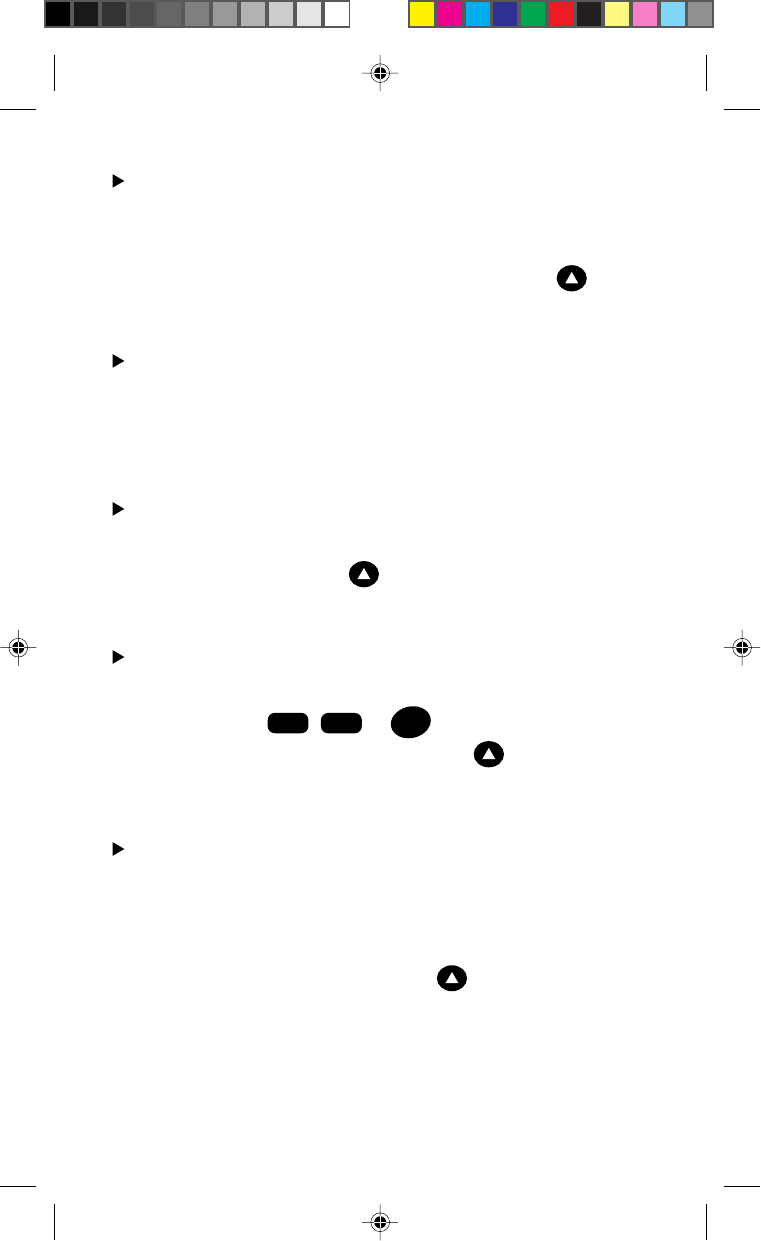
56
Key Beep (Menu 74)
You can determine the length and speed of your key beep (you
hear this when you enter the numbers). Possible settings are:
“long” and “normal.” The default is “normal.” Press under
[NEXT] to toggle between options.
One-Touch (Menu 75)
This feature allows you to turn your One-Touch (1~9)/Two-
Touch (10~99) phone book memory dialing on or off. Settings
are: “enable” and “disable.” The default is “enable.”
Privacy (Menu 76)
This feature allows you to select “enhanced” or “standard”
voice privacy mode. Press under [NEXT] to toggle
between options.
Any Key Answer (Menu 77)
You can choose to be able to press any key to answer incoming
calls (other than POWER ,
MUTE
or
END
). Possible settings are:
“on” and “off.” The default is “off.” Press under [NEXT] to
toggle between options.
Digits Find (Menu 78)
This feature allows you to activate finding out a number from
your phone’s memory when entering at least four digits you
know. Possible settings are: “DIGITS FIND on” and “DIGITS
FIND off.” The default is “on.” Press under [NEXT] to
toggle between options.
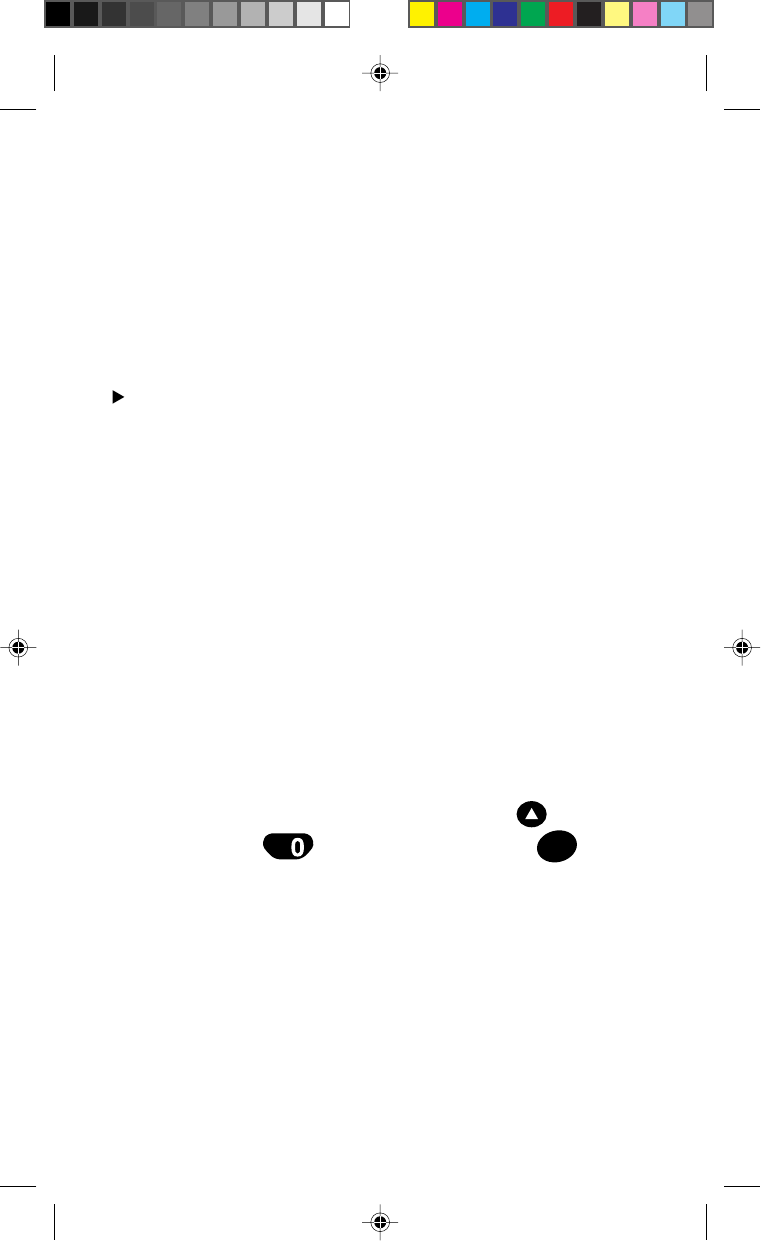
57
Choosing the analog system.
Analog System. (Menu 8) Your dual-band Sprint PCS Phone will
work like a single-band CDMA phone unless the “Analog” option
is set. If you want to use the phone in the analog system, follow
the followings.
Set Analog (Menu 81)
This option allows you to entirely stop using the phone in
analog mode, or to use the phone in analog mode within the
specified duration. Possible settings are: “DISABLED,” “This
Call” (Only for one call), “Til PWR OFF” (Turning the phone
off) or “Automatic” (Only for analog available). The default is
“DISABLED.” During the analog mode, “Analog Roam” (when
selecting “Automatic”) blinks.
Preventing accidental key press.
Keyguard. (Menu 0) You can enable keyguard with this option.
This feature locks the keypad on your phone so that keys won’t
accidentally be pushed. To enable keyguard, press under
[MENU] and then . To disable, press and hold
END
.

58
Usage guidelines:
All about performance
and safety.
Keeping tabs on signal strength.
First of all, the voice quality of your Sprint PCS Phone will always
be at its best when the antenna is fully raised. If you’re inside a
building, reception may be better near a window.
The quality of each call you make or receive depends on the signal
strength in your area. Your phone will inform you of the current
strength by displaying a number of bars next to the signal strength
icon. The more bars displayed, the stronger the signal. (See page
14 for an illustration of the signal strength indicators.)
Understanding Power Save mode.
If you’re trying to use your phone in an area where the signal is
too weak, the Power Save feature will automatically activate to
conserve battery power when you’ve been unable to pick up a
signal for 15 minutes. If your phone is on, it will periodically
recheck service availability, or you can do so yourself manually by
pressing any key. A message will be displayed on the screen any
time Power Save has been activated.

59
Understanding how your phone operates.
Your Sprint PCS Phone is basically a radio transmitter and
receiver. When it’s turned on, it receives and transmits radio
frequency (RF) signals. Your phone operates in the frequency
range of 1.9 GHz and 800 MHz. When your phone is in use, the
system handling your call controls the power level.
Radio frequency safety.
In 1991–1992, the Institute of Electrical and Electronics Engineers
(IEEE) and the American National Standards Institute (ANSI)
joined in updating ANSI’s 1982 standard for safety levels with
respect to human exposure to RF signals. More than 120 scientists,
engineers and physicians from universities, government health
agencies and industries developed this updated standard after
reviewing the available body of research. In 1993, the Federal
Communications Commission (FCC) adopted this updated
standard in a regulation. In August 1996, the FCC adopted a hybrid
standard consisting of the existing ANSI/IEEE standard and the
guidelines published by the National Council of Radiation Protec-
tion and Measurements (NCRP).
The design of the Sprint PCS Phone complies with these updated
standards. Of course, if you want to limit RF exposure even further
than the updated standard, you can choose to control the duration
of your calls and operate your phone in the most power-efficient
manner.
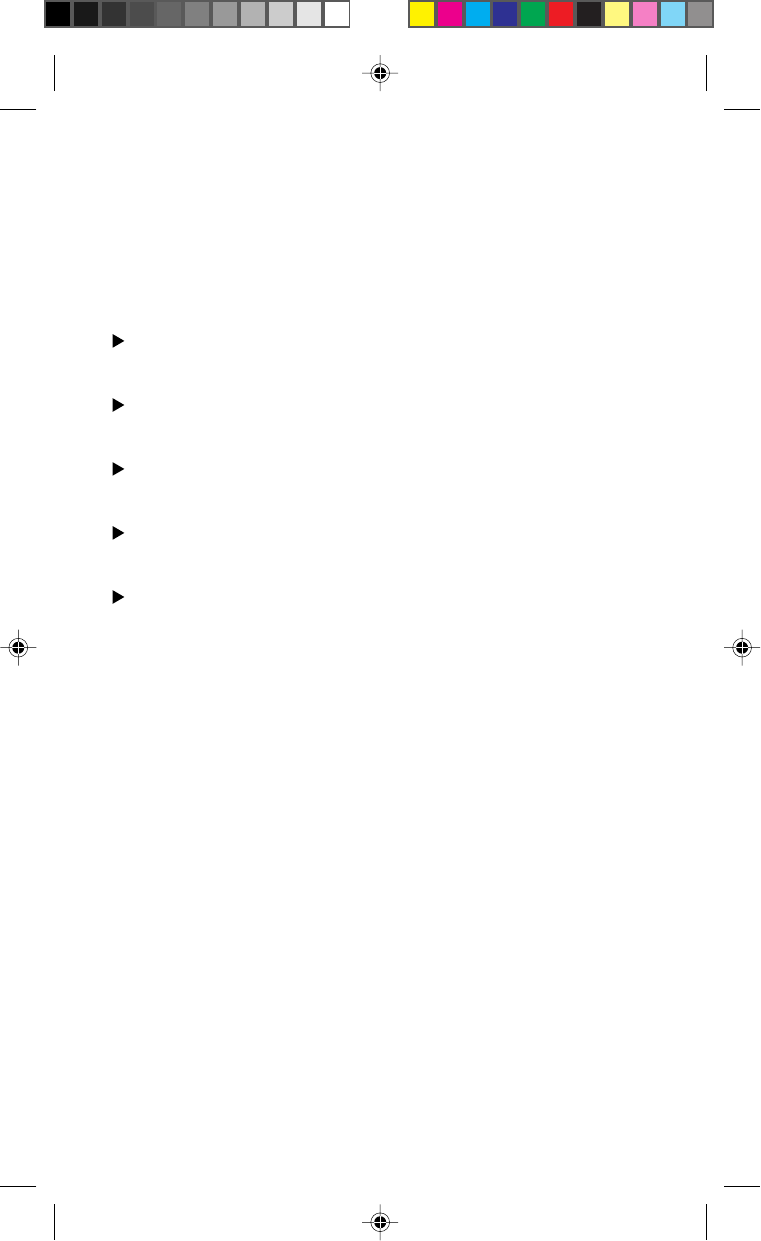
60
Maintaining your phone’s peak performance.
To operate your phone properly – that is, to maintain safe and
satisfactory service – you should follow these rules:
For best reception, extend the antenna fully.
Hold the phone with the antenna up and over your shoulder.
Do not hold the phone antenna at any time.
Do not use the phone with a damaged antenna.
Speak directly into the mouthpiece.
Avoid exposing your phone and accessories to rain or liquid spills.
If your phone does get wet, turn the power off immediately and
remove the battery pack. If it is inoperable, you should return it to
a Sprint PCS Center or call Sprint PCS Customer Care for service.
Only authorized personnel should service your phone and its
accessories. Faulty service may invalidate the warranty.

61
Protecting your battery.
For best battery performance, you should follow these guidelines:
Only use the SANYO-approved battery packs (model numbers
SCP-01LBPS and SCP-01LBPL) and AC adapter, cigarette
lighter adapter, and desktop charger (model number SCP-
01DAT for AC adapter; model number SCP-01CLA for
cigarette lighter adapter; model number SCP-01DTC for
desktop charger). These chargers are designed to maximize
battery life. Using other batteries or chargers will invalidate
your warranty and may cause damage as well.
To avoid damage, charge the battery pack only in temperatures
that range from 32˚F to 104˚F (0˚C to 40˚C).
Do not use the battery charger in direct sunlight or in high
humidity areas, such as the bathroom.
Never dispose of the battery pack by incineration.
Keep the metal contacts at the bottom of the battery pack clean.
Do not attempt to disassemble or short-circuit the battery pack.
You may need to recharge the battery pack if it has not been
used for a long period of time.

62
Replace the battery pack when it no longer provides acceptable
performance. It can be recharged hundreds of times before it
will need to be replaced.
Do not store the battery pack in high temperature areas for long
periods of time. Follow these storage rules:
Less than one month: -4˚F to 131˚F (-20˚C to 55˚C)
More than one month: -4˚F to 95˚F (-20˚C to 35˚C)
Using your phone while driving.
Talking on the phone while you’re driving may divert your
attention from the road. Besides that, it is illegal in some states.
Remember, safety comes first.
When using your Sprint PCS Phone in the car:
Focus on driving, not talking.
Use your hands-free car kit.
For details, refer to the user guide which comes with the hands-
free car kit.
If you must use the phone while driving, please use One-Touch
Dialing, Speed Dial and Any Key Answer modes.
FAILURE TO FOLLOW THESE INSTRUCTIONS MAY LEAD
TO SERIOUS PERSONAL INJURY AND POSSIBLE PROP-
ERTY DAMAGE.

63
Disposal of Lithium Ion batteries.
You can return your unwanted Lithium Ion batteries to your
nearest SANYO Service Center. For the SANYO Service Center
nearest you, call 1-800-XXX-XXXX (U.S. only).
Note: In some areas, the disposal of Lithium Ion batteries in
household or business trash may be prohibited.
Following safety guidelines.
To operate your phone safely and efficiently, you should always
follow any special regulations in a given area, and turn your phone
off in areas where use is forbidden or when it may cause interfer-
ence or danger.
Using your phone near other electronic devices.
Most modern electronic equipment is shielded from radio fre-
quency (RF) signals. However, RF signals from PCS telephones
may affect inadequately shielded electronic equipment.
RF signals may affect improperly installed or inadequately
shielded electronic operating and entertainment systems in motor
vehicles. Check with the manufacturer or its representative to
determine if these systems are adequately shielded from external
RF signals. You should also check with the manufacturer regarding
any equipment that has been added to your vehicle.

64
Consult the manufacturer of any personal medical devices (such as
pacemakers and hearing aids) to determine if they are adequately
shielded from external RF signals.
Turn off the phone in healthcare facilities and request permission
before using the phone near medical equipment.
Turn off your phone before flying.
You should turn off your Sprint PCS Phone before boarding any
aircraft. To prevent possible interference with aircraft systems,
U.S. Federal Aviation Administration (FAA) regulations require
you to have permission from a crew member to use your phone
while the plane is on the ground. To prevent any risk of interfer-
ence, FCC regulations prohibit using your phone while the plane is
in the air.
Restricting children’s access to your phone.
Your PCS phone is not a toy, and should not be played with by
children. They could hurt themselves and others, damage the
phone or make calls that increase your telephone bills.

65
Turn off your phone in dangerous areas.
To avoid interfering with blasting operations, you should turn off
your phone when in a blasting area or in other areas with signs
indicating that two-way radios should be turned off. Construction
crews often use remote-control RF devices to set off explosives.
Turn off your phone when you are in any area with a potentially
explosive atmosphere. It is rare, but your phone or its accessories
could generate sparks. Sparks could cause an explosion or a fire
resulting in bodily injury or even death.
Areas with a potentially explosive atmosphere are often, but not
always, clearly marked. They include fueling areas such as gas
station; below deck on boats; fuel or chemical transfer or storage
facilities; areas where the air contains chemicals or particles such
as grain, dust or metal powders; and any other area where you
would normally be advised to turn off your vehicle engine.
Do not transport or store flammable gas, liquid or explosives in the
compartment of your vehicle that contains your phone or accesso-
ries.

66
Cautions.
Any changes or modifications to your Sprint PCS Phone not
expressly approved in this document could void your warranty for
this equipment and void your authority to operate this equipment.
Only use approved batteries, antennas and chargers. The use of any
other type will invalidate the warranty.
FCC notice.
The phone may cause TV or radio interference if used in close
proximity to receiving equipment. The FCC can require you to
stop using the telephone if such interference cannot be eliminated.
If you need assistance, contact Sprint PCS Customer Care.
And last, but certainly not least, vehicles using liquefied petroleum
gas (such as propane or butane) must comply with the National
Fire Protection Standard (NFPA-58). For a copy of this standard,
contact the National Fire Protection Association, One
Batterymarch Park, Quincy, MA 02269, Attn: Publication Sales
Division.

67
4,901,307,
5,056,109,
5,099,204,
5,101,501,
5,103,459,
5,107,225,
5,109,390,
5,193,094,
5,228,054,
5,257,283,
5,265,119,
5,267,261,
5,267,262,
5,280,472,
5,283,536,
5,289,527,
5,307,405,
5,309,474,
5,337,338,
5,339,046,
5,341,456,
5,383,219,
5,392,287,
5,396,516,
5,608,722,
5,614,806,
5,617,060,
5,621,752,
5,621,784,
5,621,853,
5,625,876,
5,627,857,
5,629,955,
5,629,957,
5,638,412,
5,640,414,
5,642,398,
5,644,591,
5,644,596,
5,646,991,
5,652,814,
5,654,979,
5,655,220,
5,657,420,
5,659,569,
5,663,807,
Other patents
pending
5,566,357,
5,568,483,
5,574,773,
5,574,987,
D375,740,
5,576,662,
5,577,022,
5,577,265,
D375,937,
5,588,043,
D376,804,
5,589,756,
5,590,069,
5,590,406,
5,590,408,
5,592,548,
5,594,718,
5,596,570,
5,600,754,
5,602,834,
5,602,833,
5,603,096,
5,604,459,
5,604,730,
5,506,865,
5,509,015,
5,509,035,
5,511,067,
5,511,073,
5,513,176,
5,515,177,
5,517,323,
5,519,761,
5,528,593,
5,530,928,
5,533,011,
5,535,239,
5,539,531,
5,544,196,
5,544,223,
5,546,459,
5,548,812,
5,559,881,
5,559,865,
5,561,618,
5,564,083,
5,566,000,
5,566,206,
D356,560,
5,408,697,
5,414,728,
5,414,796,
5,416,797,
5,426,392,
5,437,055,
D361,065,
5,442,322,
5,442,627,
5,452,473,
5,461,639,
5,469,115,
5,469,471,
5,471,497,
5,475,870,
5,479,475,
5,483,696,
5,485,486,
5,487,175,
5,490,165,
5,497,395,
5,499,280,
5,504,773,
PATENT INFORMATION
The products/Equipment described in the attached documentation are manufactured under one or
more of the following U.S. Patents:

68
Index
A
AC adapter,
activation,
airlines, phone use prohibited by,
alerts. See beeps; tones
Alerts menu,
All calls option (Call info menu),
American National Standard
Institute (ANSI),
analog cellular networks,
Analog per call option (Analog
system menu),
Analog system menu,
answering calls,
antenna,
Any key answer option (Features
menu),
Auto answer option (Features
menu),
Auto hyphen option (Display
menu),
automatic shutoff
low battery causes and,
Power save mode,
Auto retry option (Features menu),
B
Backlight option (Display menu),
Banner option (Display menu),
battery,
approved,
charge indicator,
charging,
disposing of,
installing,
liquid spills and,
maximizing life of,
power off caution,
rain exposure and,
removing,
storing,
Beep length option for keys,
beeps
as low battery indicator,
as message indicator
as minute alert,
as service alert,
See also tones
Beep volume option for keys,
blasting areas, phone not used in,
blocking Caller ID,
building, reception inside,
butane regulation,

69
D
defaults
lock code,
deleting. See erasing
desktop charger,
dialing
from memory,
one-touch/two-touch,
from phone book,
from recent call history,
redialing,
redialing automatically,
speed dial,
See also calls
Digits find option (Features menu),
directory assistance,
disconnecting,
display indicators, .See also icons
at beginning of index
Display menu,
driving, using phone while,
dropped calls,
dual band feature,
duration of calls,
E
earpiece,
Earpiece option (Volume menu),
eavesdropping, analog cellular
networks and,
editing
emergency phone numbers,
lock code,
numbers in phone book,
See also erasing,
electronic devices, using phone
near other,
Emergency # option (Security
menu),
emergency phone numbers
calling,
calling outside Sprint PCS
Network,
C
Caller ID,
Call forwarding,
Call info menu,
calling areas,
call in progress indicator,
calls
answering,
Clear call option,
disconnecting,
duration of,
emergency,
making,
misdialing,
outside Sprint PCS Network,
redialing,
redialing automatically,
Reviewing Recent Call History,
See also dialing
CALL TO field,
Call waiting,
case of names in phone book,
CDMA networks, other PCS,
cellular networks. See analog
cellular networks
characters, erasing,
charge indicator,
charging battery,
chemical storage areas, phone not
used in,
children, protecting phone from,
cigarette lighter adapter,
Clear calls option (Security menu),
CLEAR key,
cloning, analog cellular networks
and,
CLR key. See CLEAR key
cross-talk,
customer service,
outside Sprint PCS Network,
See also servicing phone

70
saving and editing numbers,
END key,
erasing
characters,
number from phone book,
exiting menu,
explosive atmospheres, phone not
used in,
F
Fade option (Alerts menu),
fade-out,
features,
Features menu,
Federal Aviation Administration
(FAA),
Federal Communications Commis-
sion (FCC)
finding numbers,
flashing the red light at the top of
phone,
flying, phone use prohibited while,
fueling area, phone not used in ,
.See also liquefied petroleum
gas regulations
function keys. See keys
H
Hands-Free Car Kit,
hearing aid,
help,
outside Sprint PCS Network,
Home calls option (Call info
menu),
home service area, dialing outside,
hotel information,
hyphenation, automatic,
I
icons. See icons at beginning of
index
installing battery,
Institute of Electrical and Electron-
ics Engineer (IEEE),
internal phone book, See phone
book,
K
key beep option (Features menu),
key beep option (Volume menu),
Key guard menu,
keypad
locking,
keys
CLEAR,
END,
message,
POWER,
scroll,
TALK,
See also dial
L
Last call option (Call info menu),
length of calls,
liquefied petroleum gas regula-
tions,
liquid spills, exposure to,
local event information,
local service area,
lock code
changing,
default,
and restricting,
See also unlocking phone
locking keypad,
Lock option (Security menu),
long-distance call,
long number, storing,
M
medical device,
memory, dialing from,
menus

71
Alerts menu,
Analog System menu,
Call Info menu,
Display menu,
exiting,
Features menu,
Keyguard menu,
scrolling,
Security menu,
selecting option,
Vibration Feature menu,
Volume menu,
message indicator,
message key,
message reception. See voicemail
Message ring option (Volume
menu),
microphone, switching on/off
Minute option (Alerts menu),
misdialing,
MISSED CALL field,
movie listening,
MUTE key,
my number,
N
names
entering,
searching for,
National Council of Radiation
Protection and Measurements
(NCRP),
National Fire Protection Standard
(NFPA- ),
networks
dialing outside Sprint PCS
Network,
See also roaming,
New code option (Security menu),
number of calls made,
O
One-Touch/Two-Touch Dialing,
One-Touch option (Features
menu),
opening account,
outside service areas indicator,
P
pacemaker,
pass code,
pauses,
PCS CDMA networks, other,
performance, maximizing,
phone book
accessing,
advanced features,
automatic hyphenation numbers
in,
dialing number from,
editing numbers in,
erasing a number from,
maximum length of entry,
maximum numbers of entry,
names in,
pause feature,
saving numbers and names to,
See also emergency phone
number,
phone number
activating your,
for help,
for help outside Sprint PCS
Network,
looking up your own,
of SANYO Service Centers,
storing numbers. See phone
book
See also emergency phone
numbers
powering on/off,
automatically,
low battery and automatic
shutoff,
Power Save mode and
automatic shutoff,
Power Save mode,

72
service areas,
Service option (Alerts menu),
servicing phone, . See also
customer service
Set analog (Analog system menu),
setting up your voice mail,
shopping information,
Show time option (Display menu),
signal strength,
speed dial,
spill, exposure to,
Sprint PCS Account, opening,
Sprint PCS Customer care,
outside Sprint PCS Network,
Sprint PCS Directory Assistance,
Sprint PCS Network indicator,
standby mode
described,
returning to,
static,
storing battery,
T
TALK key
answering calls,
making calls,
technical support. See customer
service
telephone book. See phone book
telephone number. See phone
number
Three-Way Calling,
time/date of calls,
travel charger,
traveling,
turning phone on/off,
automatically,
low battery and automatic
shutoff,
Power Save mode and
automatic shutoff,
TV interference,
Two-Touch dialing,
Privacy option (Features menu),
propane regulations,
PWR key,
R
radio frequency interference,
radio frequency range,
radio frequency safety,
rain, exposure to,
receiving calls,
reception, maximizing,
redialing,
automatically,
red light,
restaurant information,
Restrict option (Security menu),
restricted accounts, emergency
number dialing and,
restricting children’s access to
phone,
Ringer option (Volume menu),
Ringer type option (Volume
menu),
ringer volume adjustment,
Roam calls option (Call info
menu),
roaming,
roaming indicator,
S
safety
SANYO service center, locating
nearest,
saving
emergency phone numbers,
numbers to phone book,
Scratch pad option (Features
menu),
scroll key,
searching,
Security menu,
security outside Sprint PCS
Network,

73
U
unlocking phone,
V
Version (Display menu),
Vibration feature menu,
voicemail
accessing,
accessing from another phone,
audible alert,
maximum number of message,
message indicator,
pass code,
setting up,
volume,
Volume menu,
W
warranty, voiding,